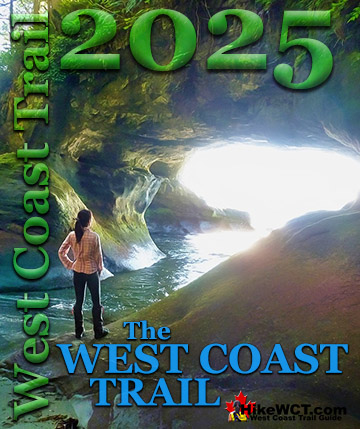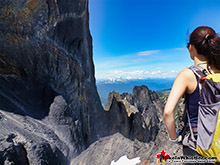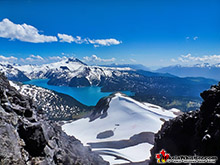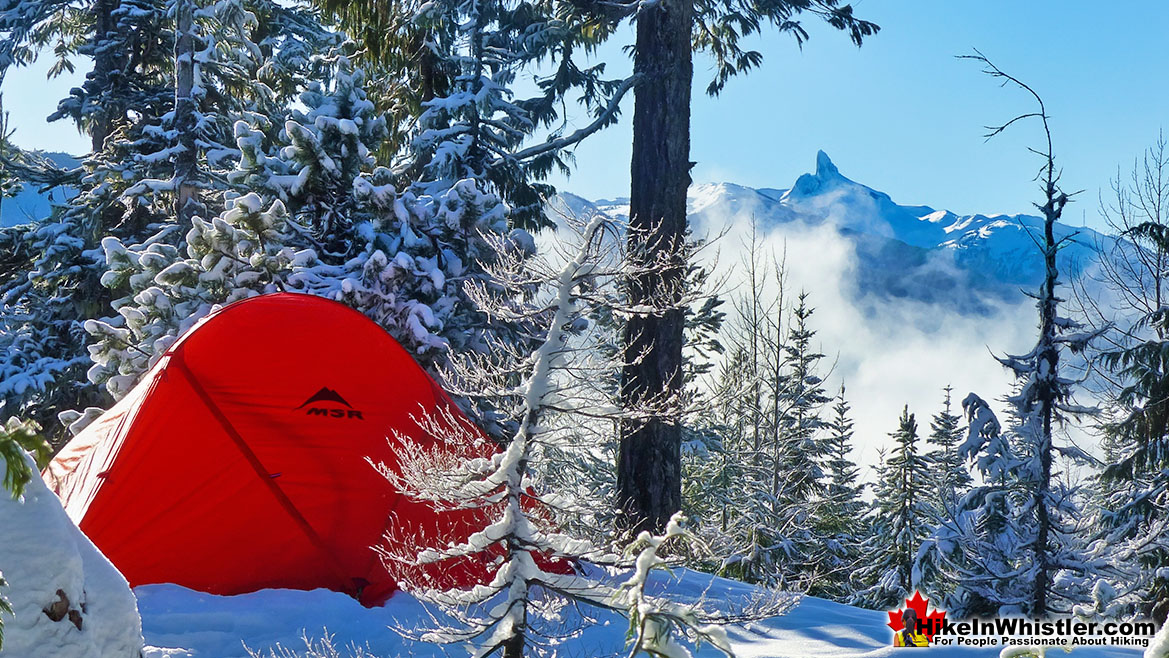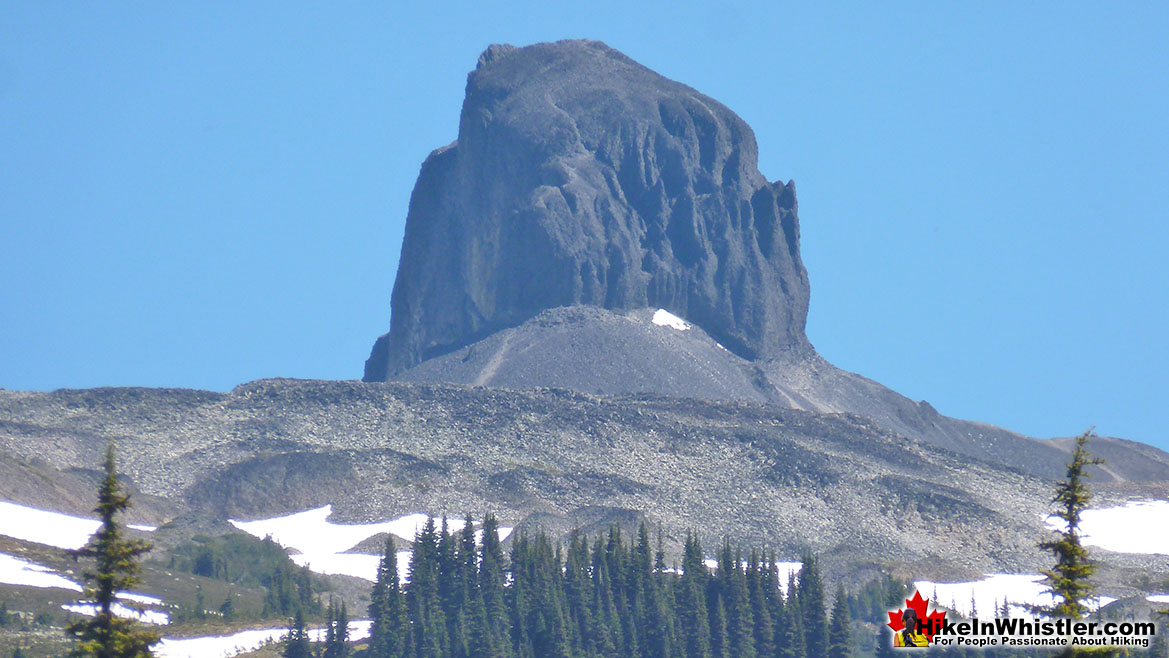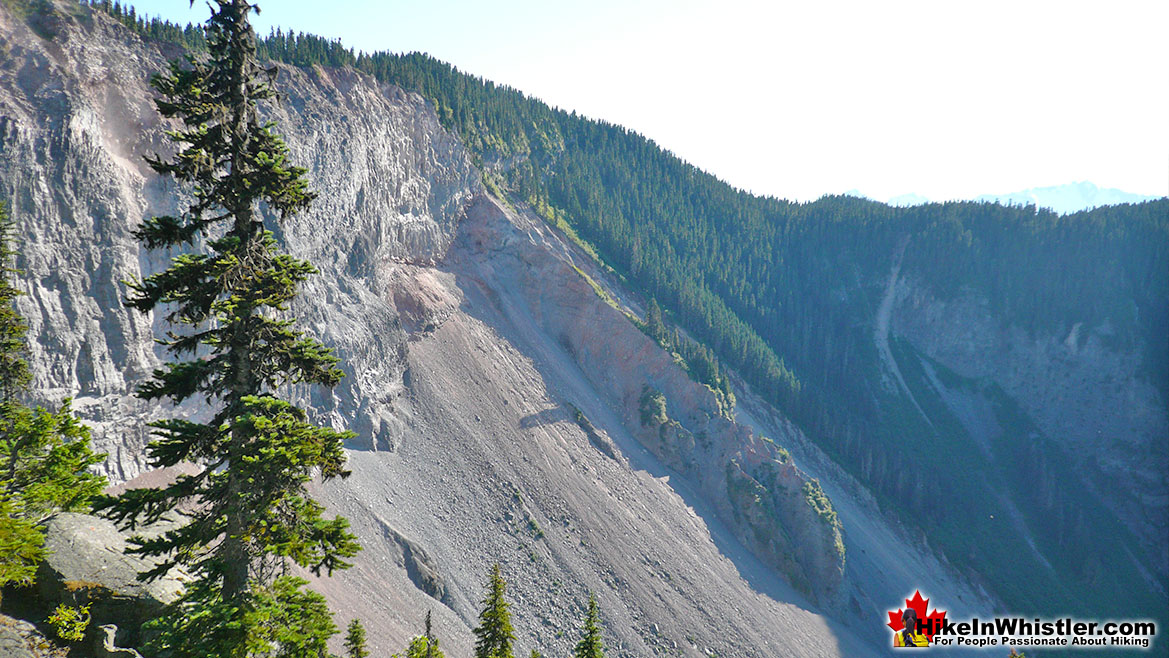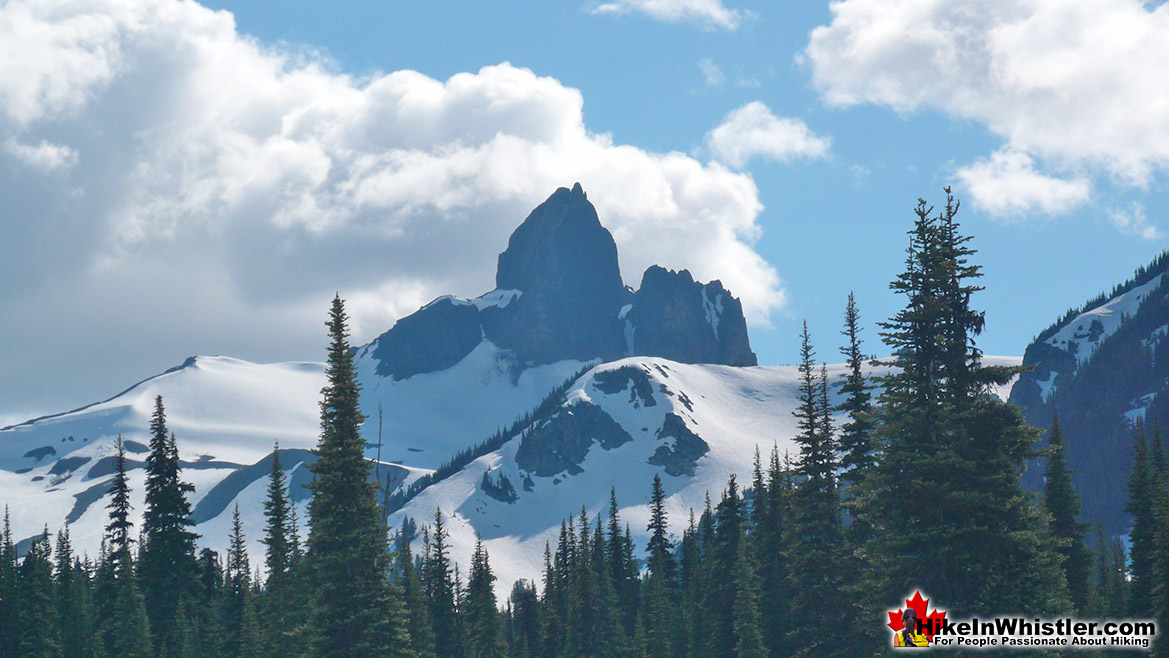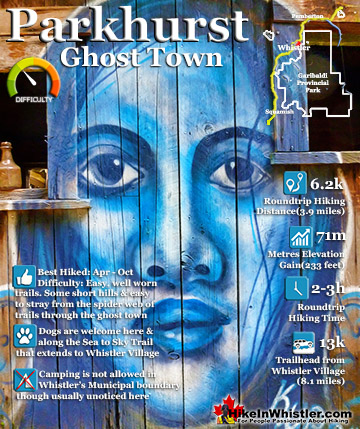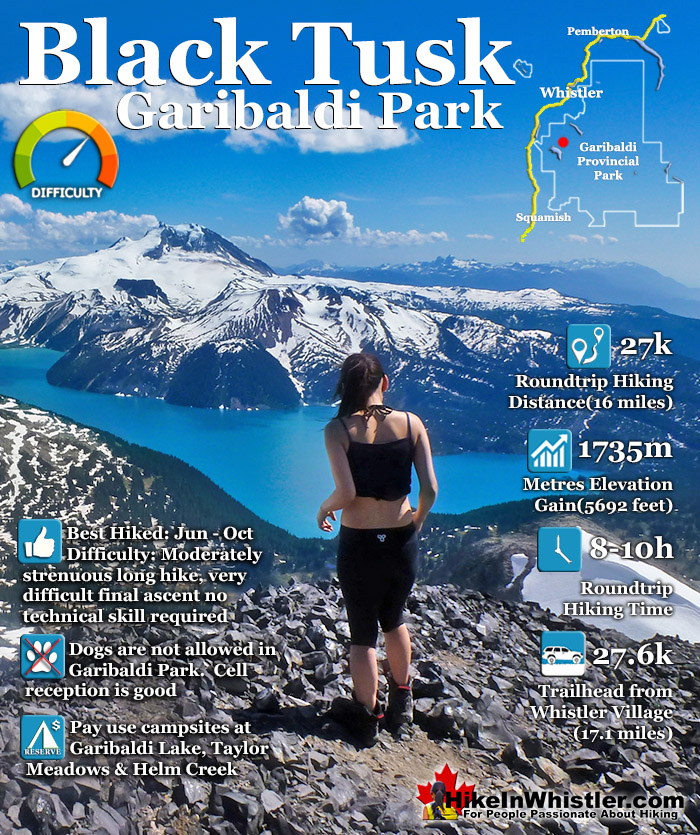
![]() Black Tusk is the extraordinarily iconic and appropriately named mountain that can be seen from almost everywhere in Whistler. The massive black spire of crumbling rock juts out of the earth in an incredibly distinct way that appears like an enormous black tusk plunging out of the ground. Whether you spot it in the distance from the top of Whistler Mountain or from vantage points along the Sea to Sky Highway, its appearance is unmistakable.
Black Tusk is the extraordinarily iconic and appropriately named mountain that can be seen from almost everywhere in Whistler. The massive black spire of crumbling rock juts out of the earth in an incredibly distinct way that appears like an enormous black tusk plunging out of the ground. Whether you spot it in the distance from the top of Whistler Mountain or from vantage points along the Sea to Sky Highway, its appearance is unmistakable.
 Stunning icon in Garibaldi Park
Stunning icon in Garibaldi Park Challenging and rewarding hike
Challenging and rewarding hike Wonderful look at an ancient volcano
Wonderful look at an ancient volcano Always changing scenery on the hike in
Always changing scenery on the hike in Many hiking options in the vast alpine
Many hiking options in the vast alpine Multiple access routes
Multiple access routes Towering & surreal view from the summit
Towering & surreal view from the summit The final chimney climb is exhilarating!
The final chimney climb is exhilarating! You can skip the summit & still be amazed
You can skip the summit & still be amazed Often crowded in the summer
Often crowded in the summer
Whistler & Garibaldi Hiking
![]() Alexander Falls
Alexander Falls ![]() Ancient Cedars
Ancient Cedars ![]() Black Tusk
Black Tusk ![]() Blackcomb Mountain
Blackcomb Mountain ![]() Brandywine Falls
Brandywine Falls ![]() Brandywine Meadows
Brandywine Meadows ![]() Brew Lake
Brew Lake ![]() Callaghan Lake
Callaghan Lake ![]() Cheakamus Lake
Cheakamus Lake ![]() Cheakamus River
Cheakamus River ![]() Cirque Lake
Cirque Lake ![]() Flank Trail
Flank Trail ![]() Garibaldi Lake
Garibaldi Lake ![]() Garibaldi Park
Garibaldi Park ![]() Helm Creek
Helm Creek ![]() Jane Lakes
Jane Lakes ![]() Joffre Lakes
Joffre Lakes ![]() Keyhole Hot Springs
Keyhole Hot Springs ![]() Logger’s Lake
Logger’s Lake ![]() Madeley Lake
Madeley Lake ![]() Meager Hot Springs
Meager Hot Springs ![]() Nairn Falls
Nairn Falls ![]() Newt Lake
Newt Lake ![]() Panorama Ridge
Panorama Ridge ![]() Parkhurst Ghost Town
Parkhurst Ghost Town ![]() Rainbow Falls
Rainbow Falls ![]() Rainbow Lake
Rainbow Lake ![]() Ring Lake
Ring Lake ![]() Russet Lake
Russet Lake ![]() Sea to Sky Trail
Sea to Sky Trail ![]() Skookumchuck Hot Springs
Skookumchuck Hot Springs ![]() Sloquet Hot Springs
Sloquet Hot Springs ![]() Sproatt East
Sproatt East ![]() Sproatt West
Sproatt West ![]() Taylor Meadows
Taylor Meadows ![]() Train Wreck
Train Wreck ![]() Wedgemount Lake
Wedgemount Lake ![]() Whistler Mountain
Whistler Mountain
![]() January
January ![]() February
February ![]() March
March ![]() April
April ![]() May
May ![]() June
June ![]() July
July ![]() August
August ![]() September
September ![]() October
October ![]() November
November ![]() December
December
Black Tusk, created in the fires of the Garibaldi Volcanic Belt and is one of the most admired and hiked to destinations in Garibaldi Provincial Park. Every angle you look at it, from far away, to closer vantage points such as Taylor Meadows, Helm Creek, Panorama Ridge or Garibaldi Lake. All views give you the certain belief that it must be impossible to hike to the top. In fact, Black Tusk seems to look more impossible to climb the closer you get to it. Even when you are close enough to touch its vertical, black and crumbling sides, you wonder in amazement how anyone can possible get up to the peak of this incredible mountain. Black Tusk is near the centre of Garibaldi Park, and is accessible from three different trailheads, all accessible via old access roads. From the nearby microwave tower(also visible from the Sea to Sky Highway). Or from the Garibaldi Park, Cheakamus Lake trailhead. Or the most popular Garibaldi Park trailhead, the Black Tusk/Garibaldi, Rubble Creek trailhead. Of the three routes, only the Cheakamus Lake trailhead and the Rubble Creek trailhead are official Garibaldi Park access points for Black Tusk. These two have large and free parking lots equipped with an outhouse at each as well as big map and information boards. Along both trails you will find good signs indicating where to hike as well as kilometre markings. Most hikers use the more direct and popular Rubble Creek trailhead, which is 13.5 kilometres or 8 miles to Black Tusk. Rubble Creek is also the most popular trailhead for Taylor Meadows and Garibaldi Lake, the two campgrounds on the way to Black Tusk, and Panorama Ridge beyond.
Black Tusk from Mount Sproatt
Black Tusk from Taylor Meadows
Black Tusk from Helm Creek Campground
Getting to the Top of Black Tusk
Incredibly, reaching the top of Black Tusk is not too difficult. It does require a scary looking, near vertical chimney climb to reach the large, somewhat flat, though sloping top of Black Tusk. This is generally regarded as the summit, however the true summit is the pinnacle you see just a few metres away, and just slightly higher. The picture below is the amazing view you get from Black Tusk overlooking Garibaldi Lake and towering Mount Garibaldi in the distance. The extraordinary, flat topped mountain below Mount Garibaldi is The Table. The Table formed into this unusual shape when a volcano pushed up through the glacier that filled this valley thousands of years ago. The pool of lava solidified into this flat topped mountain. To the right of The Table is Mount Price, which was the volcano that poured lava into the valley creating The Barrier and filling the valley with water which became Garibaldi Lake.
Spectacular View from Black Tusk

Garibaldi Park Mountains from Black Tusk
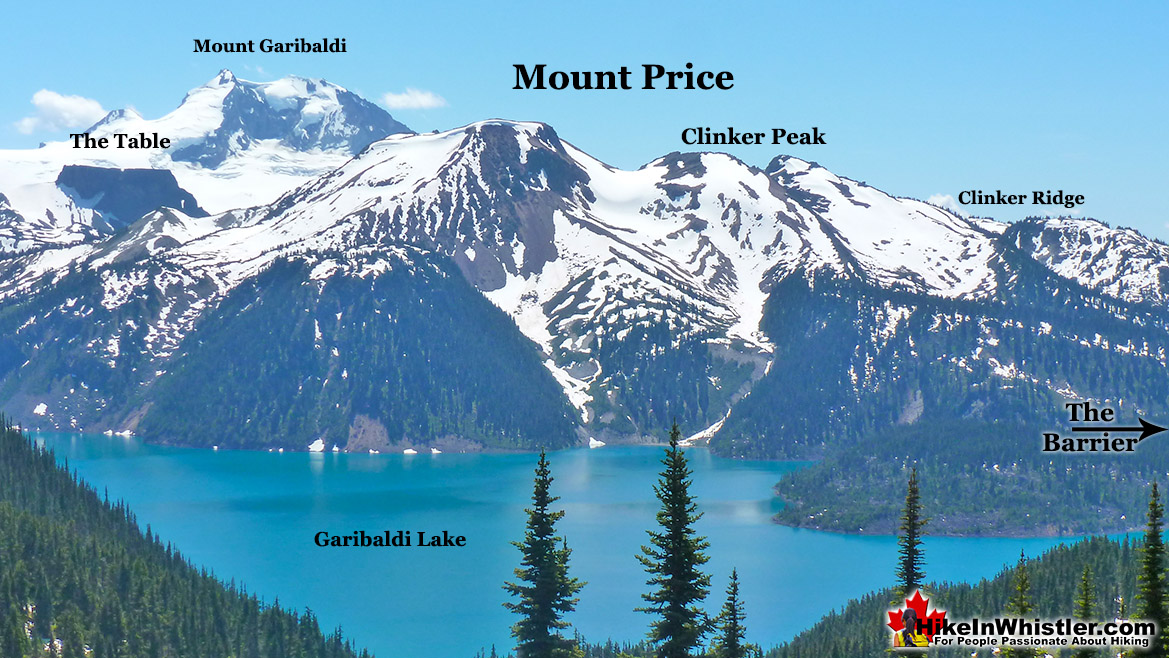
The Origin of Black Tusk
Black Tusk formed about 170,000 years ago when renewed volcanism pushed through an extinct andesitic stratovolcano that was active over a million years previously. The lava dome solidified within the old cinder cinder rich volcano which eroded away, leaving the strikingly black core we see today.

Black Tusk Map
This map shows the different ways to hike to Black Tusk. The Rubble Creek trailhead is the usual route for most, with the two popular campgrounds on the way at Taylor Meadows and Garibaldi Lake. You can also hike to Black Tusk from the Cheakamus Lake trailhead via the Helm Creek trail. The Microwave Tower road is also an option, though the access road is usually gated so you have to hike up the long and boring road.
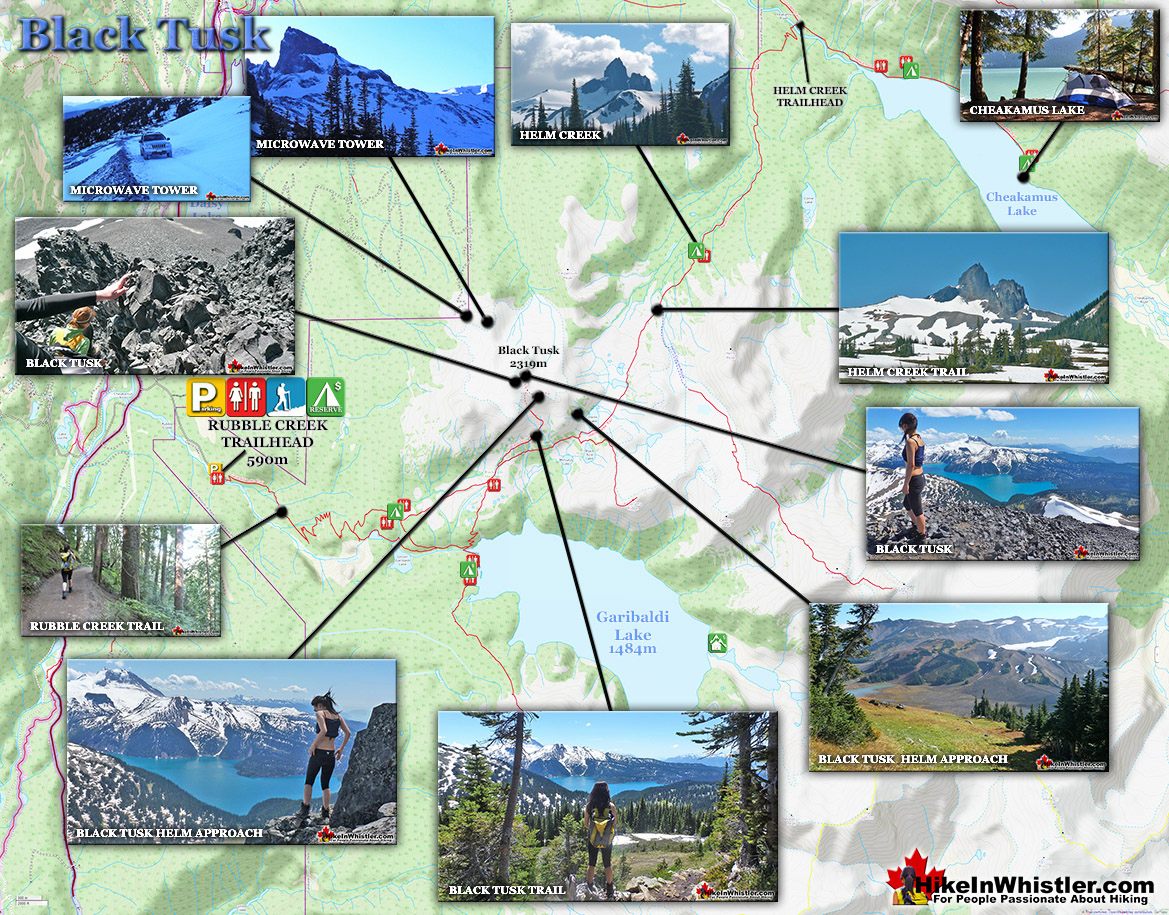
Various Ways to Hike to Black Tusk
The microwave tower access road takes you very close to Black Tusk, and has a fairly good gravel 4x4 road to it, however is blocked several kilometres away by a vehicle gate. This is potentially a good way to hike to Black Tusk, however this annoying gate makes what should be a short hike, a long and tedious one. Also, there are of course no signs indicating where to go once you reach the microwave tower. This route is currently being considered to be opened to allow vehicles to park at or near the microwave tower, however, little progress has been made so far. Occasionally you will find this gate open, however driving past this point may get you in trouble. The Cheakamus Lake trailhead route to get to Black Tusk is a good option as it is quiet, serene and takes you over the beautiful Cheakamus River via suspension bridge and through the wonderfully remote Helm Creek campground. It is, however, quite long at over 15 kilometres each way to the summit of Black Tusk and part of this route is unmarked, requires some route-finding, and a wet crossing of Helm Creek. It is a good option if you are keen on avoiding crowds as the beautiful Helm Creek campground has only about a dozen tent platforms and more often than not, are mostly deserted. Helm Creek is also the gateway to quite a few other great hikes. A quick look at the map above shows some of the amazing sights around Black Tusk.
Black Tusk View of Mount Garibaldi
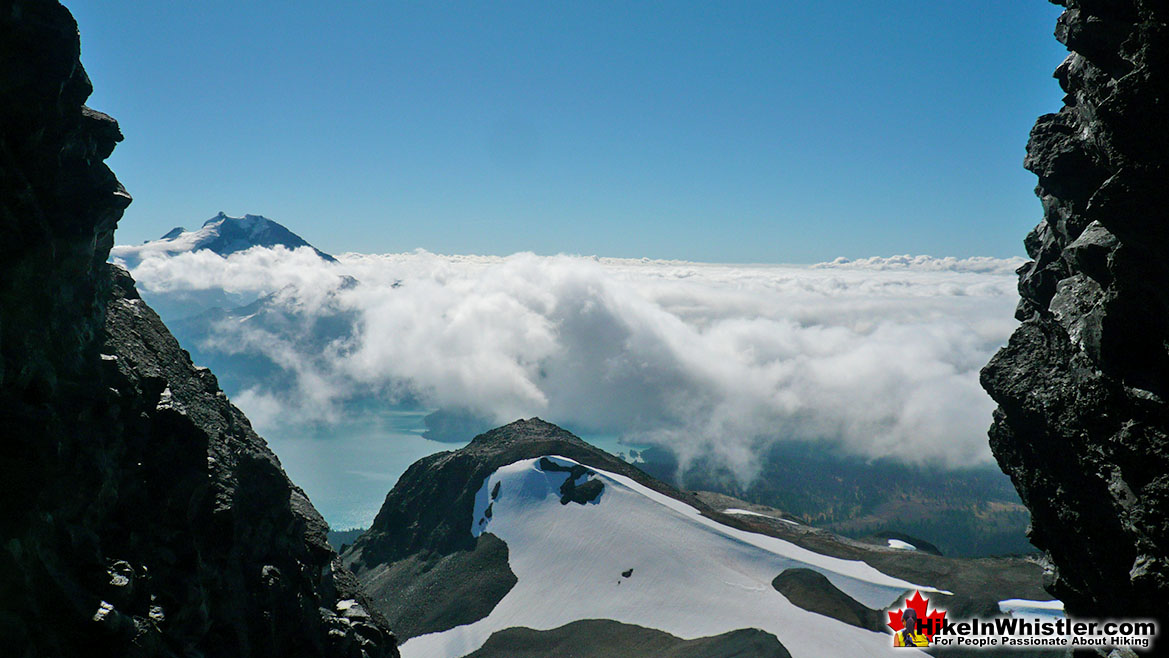
The Rubble Creek trailhead is, for most hikers, the best trailhead option for Black Tusk. It is easy to find, clearly marked and the most direct route. The Cheakamus Lake trailhead is a bit longer and you have to leave the marked trail to ascend to Black Tusk. Though this unmarked route is straightforward and surprisingly easy, as it is unmarked it requires a bit of guesswork that may be intimidating. The Cheakamus Lake trailhead route also lacks one other wonderful attribute that the Rubble Creek route has, a pit-stop at Garibaldi Lake. This less than 30 minute detour(one way) allows for a spectacular place to cool off in an always frigid, glacier fed lake!
The Rubble Creek Trailhead - Black Tusk
![]() The most popular, scenic and direct hiking trail to Black Tusk is from the popular Rubble Creek trailhead, just off the Sea to Sky Highway, 25 kilometres south of Whistler Village. As this trailhead is also the best route to access Garibaldi Lake, Taylor Meadows and Panorama Ridge, it is sometimes very busy and some weekends find both campgrounds full. The Rubble Creek trailhead is easy to find, just keep your eye out for the large Garibaldi Park highway sign that reads, "Black Tusk(Garibaldi)" along the side of the Sea to Sky Highway 25 kilometres south of Whistler Village. The huge and free trailhead parking has a map and information board as well as an outhouse. Reservations are required for: Garibaldi Lake, Taylor Meadows, Helm Creek & Cheakamus Lake campgrounds. Since 2018, camping reservations are required year-round, wherever you park in Garibaldi Provincial Park.
The most popular, scenic and direct hiking trail to Black Tusk is from the popular Rubble Creek trailhead, just off the Sea to Sky Highway, 25 kilometres south of Whistler Village. As this trailhead is also the best route to access Garibaldi Lake, Taylor Meadows and Panorama Ridge, it is sometimes very busy and some weekends find both campgrounds full. The Rubble Creek trailhead is easy to find, just keep your eye out for the large Garibaldi Park highway sign that reads, "Black Tusk(Garibaldi)" along the side of the Sea to Sky Highway 25 kilometres south of Whistler Village. The huge and free trailhead parking has a map and information board as well as an outhouse. Reservations are required for: Garibaldi Lake, Taylor Meadows, Helm Creek & Cheakamus Lake campgrounds. Since 2018, camping reservations are required year-round, wherever you park in Garibaldi Provincial Park.
Black Tusk Trail View of Garibaldi Lake

Rubble Creek and The Barrier
Rubble Creek is so named because of the large boulder(rubble) field deposited from The Barrier in previous, massive debris flows. The last occurred 80 years ago, when The Barrier partly gave way and an estimated thirty million cubic metres of rock crashed down near the now, Rubble Creek trailhead. The Barrier can be viewed along the trail to Garibaldi Lake just past the y junction after the 6 kilometre mark along the trail. A sign indicates the short path to the viewpoint. The trail from Rubble Creek starts off by quickly ascending a wide, dirt path into deep forest. For the first 6 kilometres you only catch glimpses of the sky through the the thick forest of startlingly tall trees. Several switchbacks along the trail continue until you get to the first fork in the trail about 6.2 kilometres from the trailhead. Right takes you to past The Barrier, Lesser Garibaldi Lake and then to Garibaldi Lake (in 3 kilometres). There is a nice mapboard at this trail junction which gives you a good chance to plot your course. A good way to hike if doing a one day hike is to take this left fork through Taylor Meadows and then return via Garibaldi Lake for a swim near the end of the journey. The Taylor Meadows route is also slightly shorter to Black Tusk than the Garibaldi Lake direction and therefore gets you to your goal quicker.
The Barrier Above Rubble Creek
Trail Forks to Taylor Meadows or Garibaldi Lake
If you take the left fork toward Taylor Meadows you will finally escape the heavy forest cover and emerge to spectacular scenery in about 20 minutes. Taylor Meadows is in a beautiful valley of gnarled, weather beaten trees, endless green meadows and in July and August, alpine flowers as far as you can see. What immediately comes into view towering in the distance is Black Tusk and the wooden boardwalk through Taylor Meadows continues straight as Black Tusk looms far ahead and to your left. This is where you will start taking photos almost continuously of Black Tusk, and probably not stop until you touch its sheer black sides. Though you are only half way there, from now on the views from the trail are amazing, varied, and progressively better. Just past Taylor Meadows the boardwalk ends and the dirt trail crosses a creek and then past a small, locked BC Parks building and another trail junction. The trail to the right leads to Garibaldi Lake and campsite area in 2 kilometres. The trail that continues straight goes to Black Tusk(5.5k), the Panorama Ridge(7k) and much further away, Helm Creek(9.2k) and Cheakamus Lake(18k). The views along this 2 kilometre section of trail between this junction and the Black Tusk junction are beautiful. Green meadows, flowers everywhere you look. Distant snow capped mountains and the starkly beautiful Black Tusk towering to your left.
Taylor Meadows Near Black Tusk
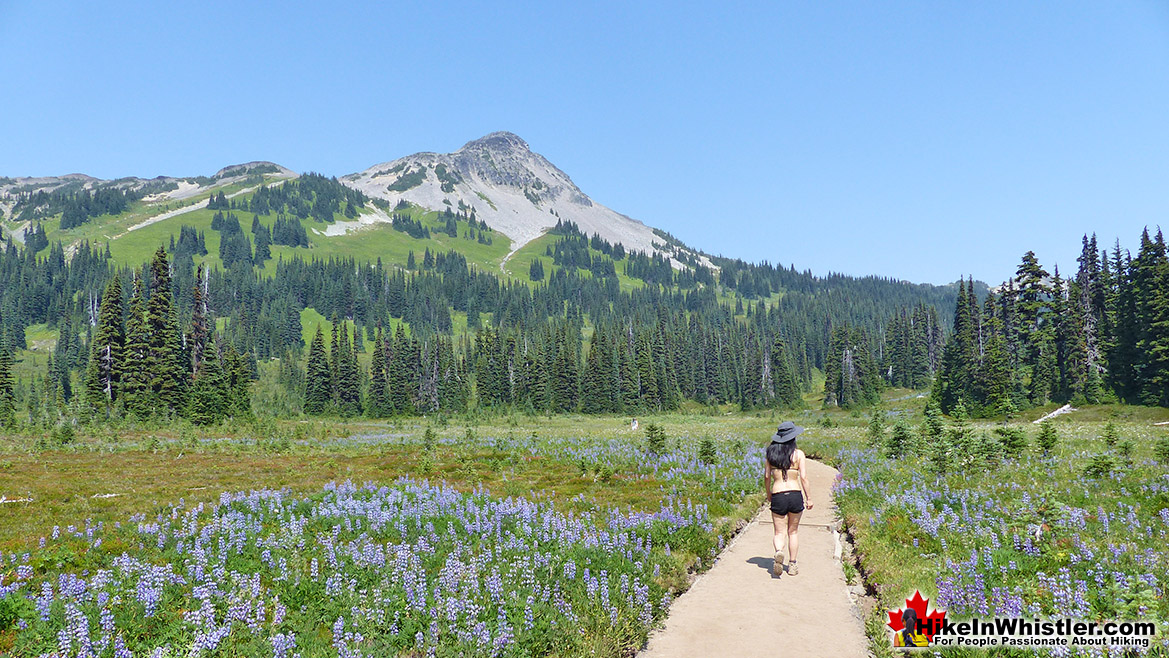
Trails to Black Tusk and Panorama Ridge
The next junction you come to has a nice mapboard and more nice kilometre markings and direction signs. Once again you can turn right and head towards Garibaldi Lake or continue straight for Black Tusk, Panorama Ridge, Helm Creek and Cheakamus Lake. There is an outhouse here and ropes along the edge of the trail here to try to keep hikers on the trail. The area is ideal for camping with a beautiful creek and endless flat grassy areas, however a sign indicates not to camp here in order to not damage the fragile alpine areas off the trail. In just a hundred metres further another fork in the trail takes you left towards Black Tusk(3k) or straight toward Panorama Ridge(4.5k), and you begin ascending steadily through patches of forest occasionally breaking to reveal amazing views of Garibaldi Lake to your right and Black Tusk on your left. This section of trail, from this junction to Black Tusk is fairly steep and the most challenging. You will cross dozens of tiny creeks so water is never in short supply. This section of trail is often snow covered well into July, however, the snow is hard-packed, easy to walk on, and the trail is hard to stray from.
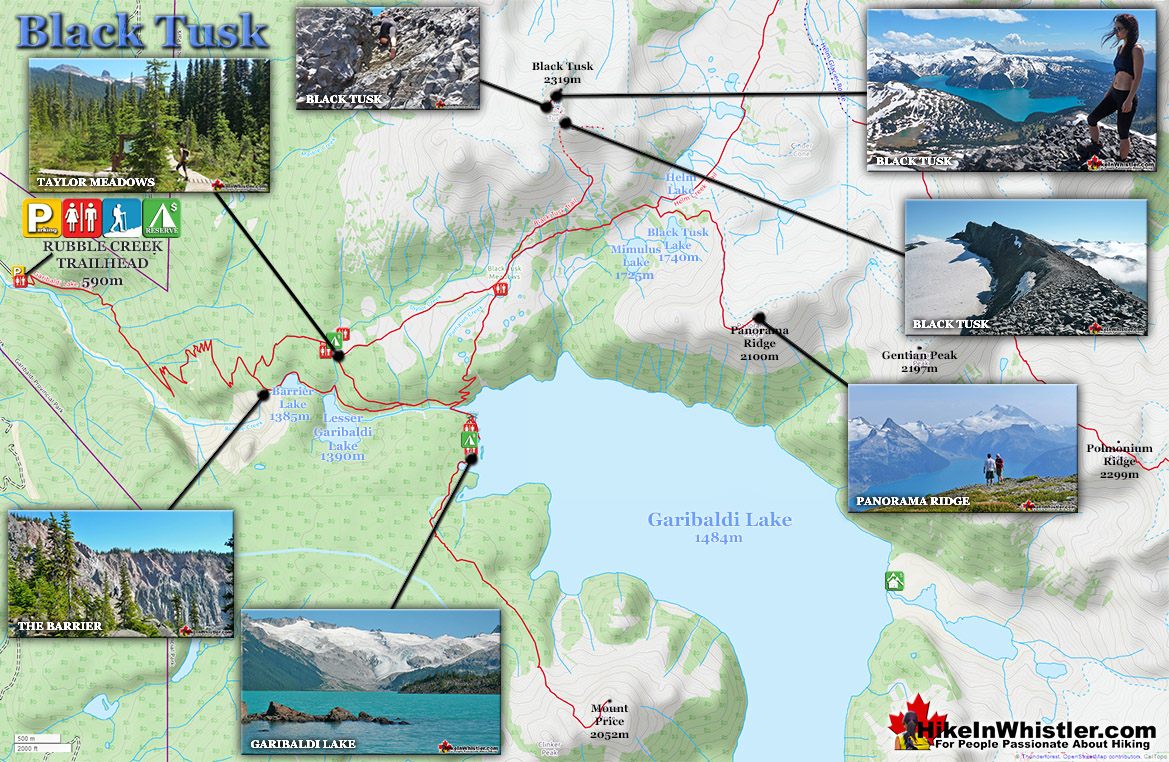
Scree Slopes Around Black Tusk
As you approach Black Tusk you will begin walking on the massive scree slopes that surround it. On a sunny day you will immediately feel the warmth from the black rocks underfoot. Due to the increasing elevation the temperatures will have noticeably fallen quite a bit as compared to Taylor Meadows, however the heat from the black rocks on a sunny day more than counter this drop in temperature. You will likely find yourself putting on a sweater after the Black Tusk junction and then taking it off again once you near Black Tusk and feel this heat rising from the ground. The steep scree slope leads to a ridge adjacent to Black Tusk. To your left the obvious route takes you to Black Tusk and the increasingly sketchy route along the edge of its base. Following this route you will occasionally look straight up and while marvelling at the enormous, vertical edge of Black Tusk, wonder about odds of one of the millions of crumbling chunks of Black Tusk dropping from high above, onto your head.
Route Around Black Tusk to the Chimney

Below, on the far left of the picture, you can see people gathered at the bottom of the chimney and people climbing up to the top of Black Tusk.
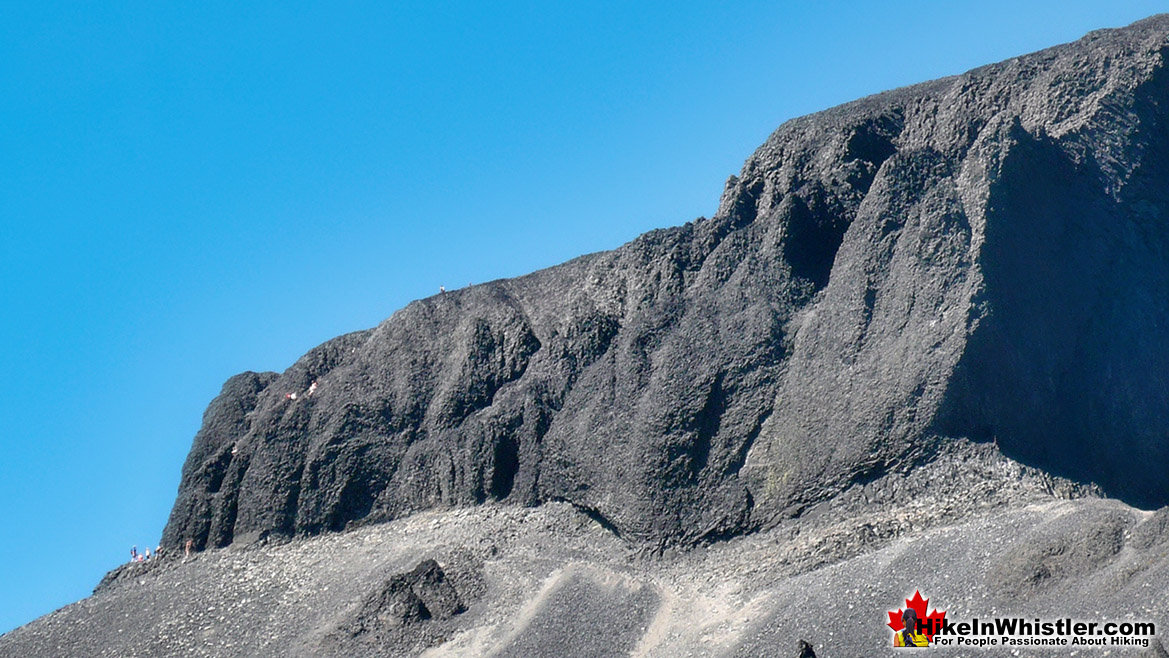
The Black Tusk Chimney
As you scramble along the edge of Black Tusk you come to a narrow gap heading almost straight up. In mountaineering lingo a gap like this between two vertical faces of rock is called a chimney. This chimney up Black Tusk is challenging, but thankfully it is very short. The steepness decreases after just three metres and then you reach another much easier and not very steep chimney, this second one is marked with an orange trail marker. When first arriving at the lower chimney you will wonder, as almost everyone else at this spot, “I don’t think this is a safe way to go.” Then you pause and look around, taking in the view, spectacular. Just spectacular. Above the clouds, looking over the impossibly blue Garibaldi Lake, nestled in endless snowy mountains. There is even snow, more accurately a glacier just below you, in the valleys of scree that crumbled from Black Tusk. The scree is black, very black. Basketball sized boulders litter the glacier far below. Contrasting colours of the snow, clouds, lake and sky, the view is incredible.
Black Tusk Chimney Climb to the Top

Lots of people don’t climb the chimney to the top, it’s that scary looking. This is justifiable. It is unquestionably unsafe. Chunky rock holds pull free as you grip them. Above you jet black, jagged rocks tumble and ricochet down on and around you. And the view is so spectacular around you that it’s easy to justify turning around here. But the final ascent is not really that hard. Keep your head down, three points of contact at all times, slow and steady and you reach the top of the world. Garibaldi Provincial Park surrounds you far below is a surreal panorama that takes whole minutes to sink in. The summit of Black Tusk is a wonderful place. Technically, this is not the true summit of Black Tusk. The true summit is across a deep gorge adjacent to here and just a few metres higher, but difficult and dangerous to reach.
Peering Over the Edge of Black Tusk
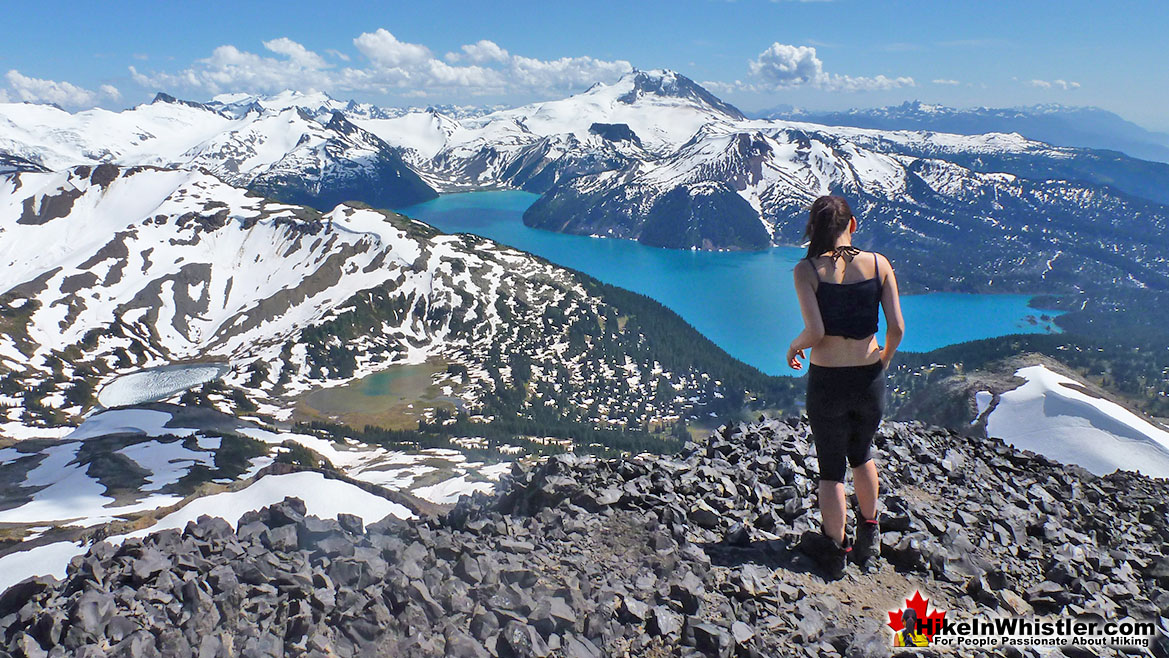
The Crumbling Top of Black Tusk

The Sloping Top of Black Tusk
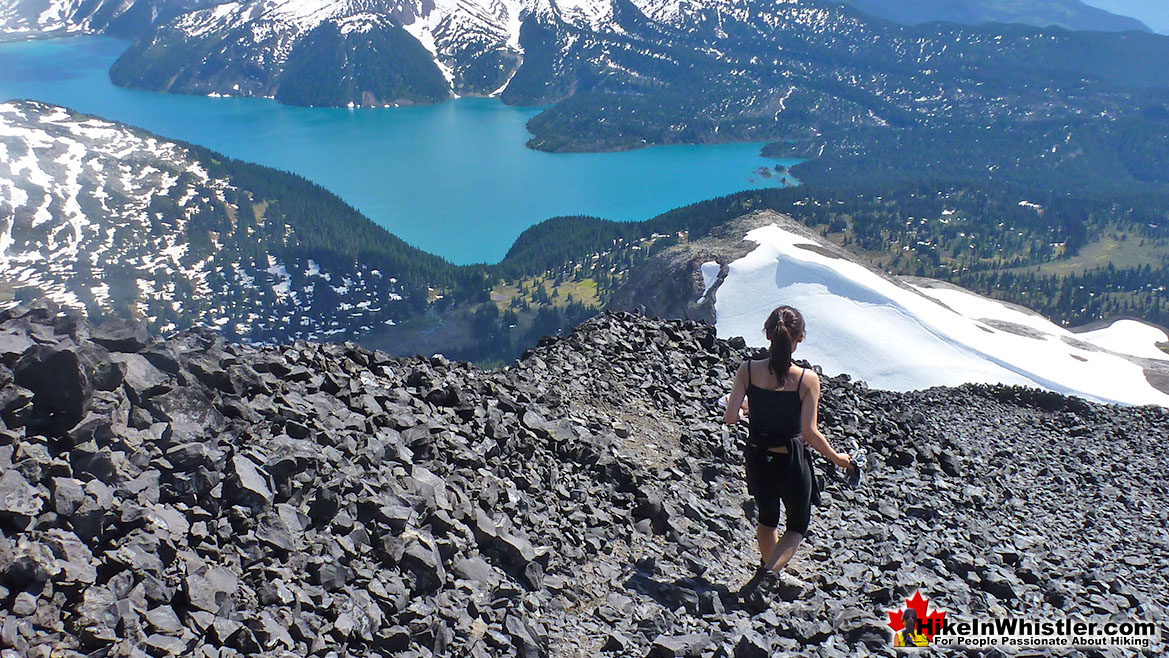
Climbing Back Down the Chimney
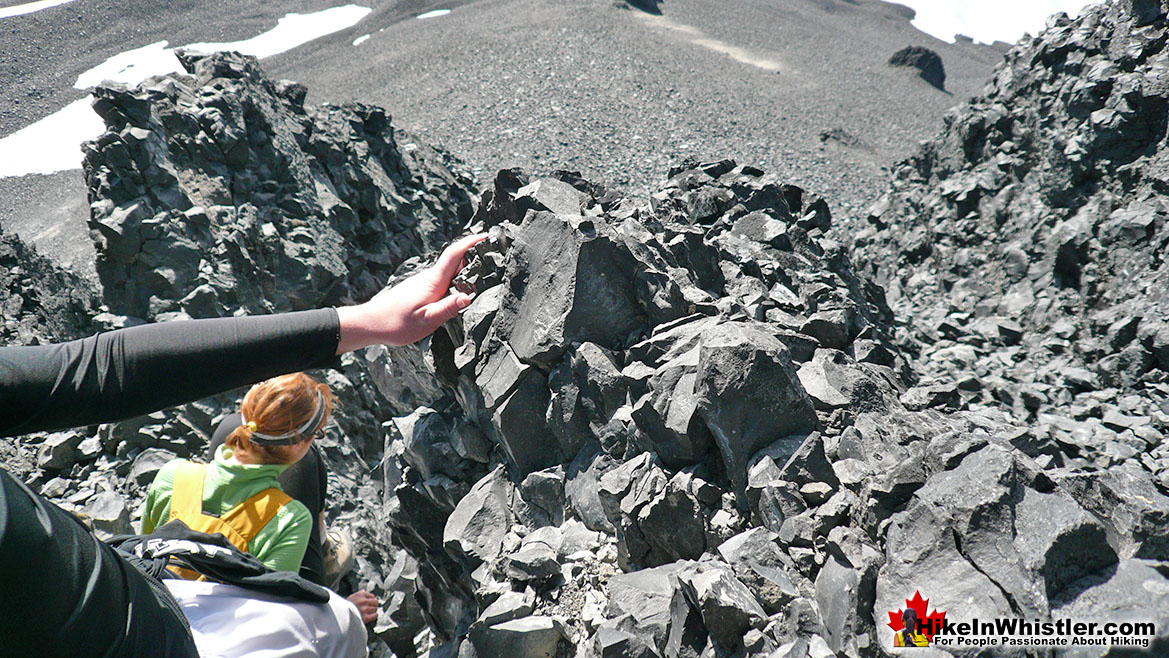
Trailhead & Parking Directions to Black Tusk
![]() Rubble Creek is the most popular route to Black Tusk and consequently the most chaotic. The three big parking areas fill up on busy weekends, however the long access road seems to have enough room to accommodate the busiest long weekends. This road is the only paved(not a heavily potholed, gravel road) to access a trailhead to Black Tusk. Though very busy, the Rubble Creek trail to Black Tusk is constantly maintained to a high standard. Plenty of helpful BC Parks Garibaldi Park mapboards and trail signs keep you on track and aware of where you are. The tidy, natural dirt trail is wide enough to hike side-by-side most of the time. The constant ascent from here gets you to the summit of Black Tusk in 13.5 kilometres(8.4 miles). To get to Rubble Creek, drive south from Whistler Village(zero your odometer at Village Gate Boulevard) on Hwy 99. At 24.7 kilometres look for the Black Tusk(Garibaldi) sign on the highway indicating you to turn left. There is a nice, and long dedicated left turn lane on the highway here to allow you to safely exit the highway. There is a fork in the road a couple hundred metre up Daisy Lake Road. Take the right fork and continue up the paved road for 2 kilometres to the Garibaldi Park, Rubble Creek trailhead for Black Tusk, Taylor Meadows, Panorama Ridge, Garibaldi Lake and much more.
Rubble Creek is the most popular route to Black Tusk and consequently the most chaotic. The three big parking areas fill up on busy weekends, however the long access road seems to have enough room to accommodate the busiest long weekends. This road is the only paved(not a heavily potholed, gravel road) to access a trailhead to Black Tusk. Though very busy, the Rubble Creek trail to Black Tusk is constantly maintained to a high standard. Plenty of helpful BC Parks Garibaldi Park mapboards and trail signs keep you on track and aware of where you are. The tidy, natural dirt trail is wide enough to hike side-by-side most of the time. The constant ascent from here gets you to the summit of Black Tusk in 13.5 kilometres(8.4 miles). To get to Rubble Creek, drive south from Whistler Village(zero your odometer at Village Gate Boulevard) on Hwy 99. At 24.7 kilometres look for the Black Tusk(Garibaldi) sign on the highway indicating you to turn left. There is a nice, and long dedicated left turn lane on the highway here to allow you to safely exit the highway. There is a fork in the road a couple hundred metre up Daisy Lake Road. Take the right fork and continue up the paved road for 2 kilometres to the Garibaldi Park, Rubble Creek trailhead for Black Tusk, Taylor Meadows, Panorama Ridge, Garibaldi Lake and much more.
Rubble Creek Trailhead Parking for Black Tusk
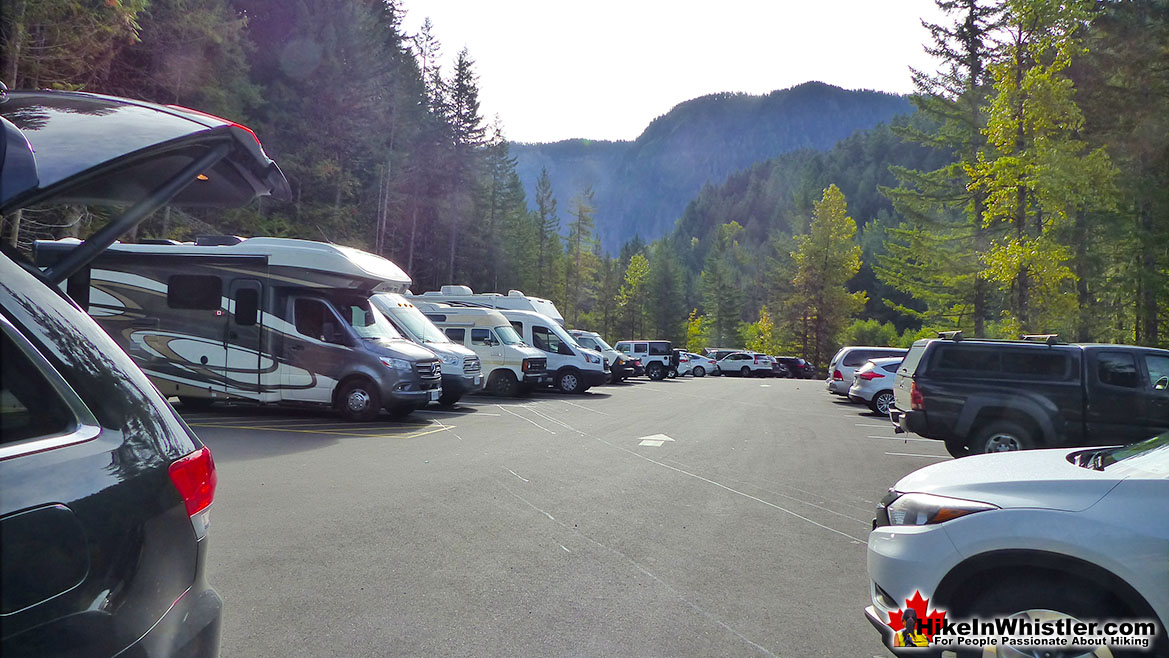
Black Tusk Rubble Creek Trailhead Driving Directions Map

The Cheakamus Lake/Helm Creek Route to Black Tusk
![]() The Cheakamus Lake trailhead route to get to Black Tusk is a good option as it is quiet, serene and takes you over the beautiful Cheakamus River via suspension bridge and through the wonderfully remote Helm Creek campground. It is, however, quite long at over 15 kilometres each way to the summit of Black Tusk and part of this route is unmarked, requires some route-finding, and a wet crossing of Helm Creek. It is a good option if you are keen on avoiding crowds as the beautiful Helm Creek campground has only about a dozen tent platforms and is always less busy than the campgrounds at Taylor Meadows and Garibaldi Lake.
The Cheakamus Lake trailhead route to get to Black Tusk is a good option as it is quiet, serene and takes you over the beautiful Cheakamus River via suspension bridge and through the wonderfully remote Helm Creek campground. It is, however, quite long at over 15 kilometres each way to the summit of Black Tusk and part of this route is unmarked, requires some route-finding, and a wet crossing of Helm Creek. It is a good option if you are keen on avoiding crowds as the beautiful Helm Creek campground has only about a dozen tent platforms and is always less busy than the campgrounds at Taylor Meadows and Garibaldi Lake.
Helm Creek Campground View of Black Tusk
Trailhead & Parking Directions Map for Cheakamus Lake
![]()
 The Cheakamus Lake trailhead access to Garibaldi Park is an excellent and quieter access route to Black Tusk. The 8 kilometre access road is very potholed, however most cars should make it easily, though slowly. From Village Gate Boulevard in Whistler Village, drive south on the Sea to Sky Highway(Hwy 99) for 7.7 kilometres to the intersection at Function Junction. Turn left onto Cheakamus Lake Road toward Cheakamus Crossing. In 300 metres turn left on the the gravel road section of Cheakamus Lake Road. Follow this very potholed road for 8 kilometres to the Cheakamus Lake trailhead. 1.5 kilometres along the trail you will see a sign on the right for Helm Creek. Follow this to the Helm Creek campground(8.5 kilometres from the Cheakamus Lake trailhead). Black Tusk dominates the skyline from Helm Creek and the trail continues to Black Tusk, Panorama Ridge and Garibaldi Lake from here.
The Cheakamus Lake trailhead access to Garibaldi Park is an excellent and quieter access route to Black Tusk. The 8 kilometre access road is very potholed, however most cars should make it easily, though slowly. From Village Gate Boulevard in Whistler Village, drive south on the Sea to Sky Highway(Hwy 99) for 7.7 kilometres to the intersection at Function Junction. Turn left onto Cheakamus Lake Road toward Cheakamus Crossing. In 300 metres turn left on the the gravel road section of Cheakamus Lake Road. Follow this very potholed road for 8 kilometres to the Cheakamus Lake trailhead. 1.5 kilometres along the trail you will see a sign on the right for Helm Creek. Follow this to the Helm Creek campground(8.5 kilometres from the Cheakamus Lake trailhead). Black Tusk dominates the skyline from Helm Creek and the trail continues to Black Tusk, Panorama Ridge and Garibaldi Lake from here.

The Microwave Tower Route
![]() The microwave tower access road takes you very close to Black Tusk, and has a fairly good gravel 4x4 road to it, however is blocked several kilometres away by a vehicle gate. This is potentially a good way to hike to Black Tusk, however this annoying gate makes what should be a short hike, a long and tedious one. Also, there are of course no signs indicating where to go once you reach the microwave tower. This route is currently being considered to be opened to allow vehicles to park at or near the microwave tower, however, little progress has been made so far. It is not unusual to find this gate open, however, driving past this point may get you in trouble. This is not an official Garibaldi Park trailhead access point and you should use it with caution because you will not have helpful signs and mapboards to guide you.
The microwave tower access road takes you very close to Black Tusk, and has a fairly good gravel 4x4 road to it, however is blocked several kilometres away by a vehicle gate. This is potentially a good way to hike to Black Tusk, however this annoying gate makes what should be a short hike, a long and tedious one. Also, there are of course no signs indicating where to go once you reach the microwave tower. This route is currently being considered to be opened to allow vehicles to park at or near the microwave tower, however, little progress has been made so far. It is not unusual to find this gate open, however, driving past this point may get you in trouble. This is not an official Garibaldi Park trailhead access point and you should use it with caution because you will not have helpful signs and mapboards to guide you.
Black Tusk from the Microwave Tower
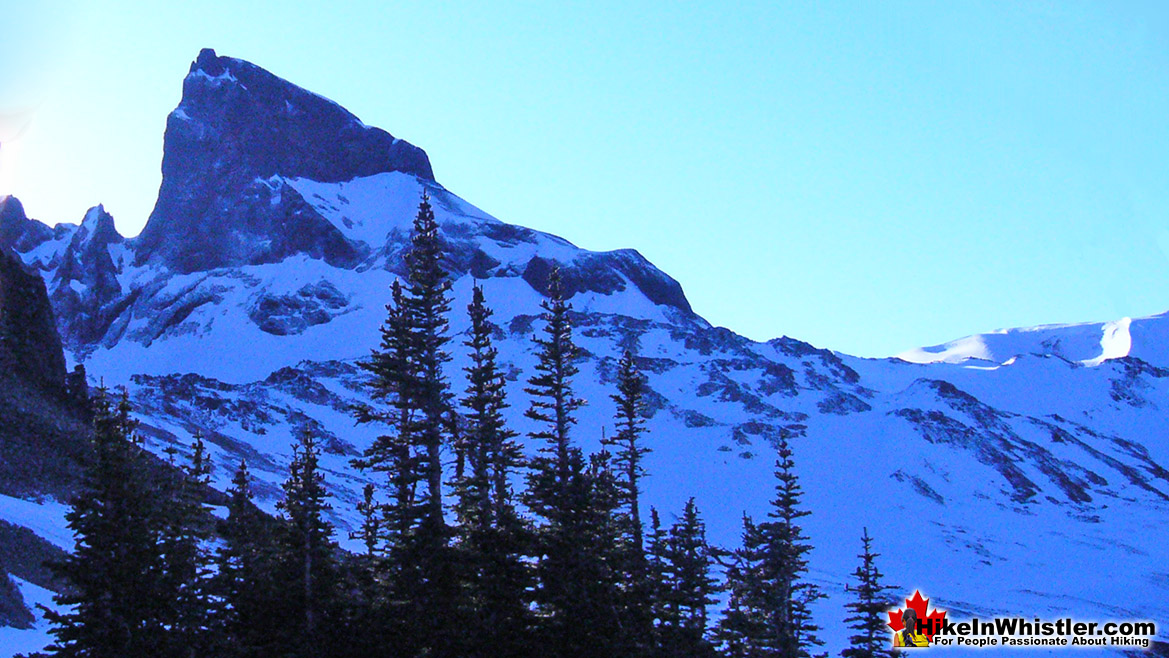
Parking Directions Map for the Microwave Tower
![]() The microwave tower is pretty straight forward to get to. Most cars can manage the access road, though with a few steep, potholed sections. From Village Gate Blvd in Whistler Village, drive south on Hwy 99 for 7.9 kilometres to the intersection at Function Junction/Cheakamus Crossing. Turn left onto Cheakamus Lake Road toward Cheakamus Crossing. In 400 metres turn left onto the gravel section of Cheakamus Lake Road. In just 150 metres turn right onto Westside Main, cross the bridge over Cheakamus River and drive past the parking area for Logger’s Lake. Keep driving the increasingly bad and steep logging road until you come to the locked gate. Park well to the side to not block access as this road is frequently used by maintenance crews to drive to the microwave tower. The trucks they use are enormous, so leave plenty of room to get past you.
The microwave tower is pretty straight forward to get to. Most cars can manage the access road, though with a few steep, potholed sections. From Village Gate Blvd in Whistler Village, drive south on Hwy 99 for 7.9 kilometres to the intersection at Function Junction/Cheakamus Crossing. Turn left onto Cheakamus Lake Road toward Cheakamus Crossing. In 400 metres turn left onto the gravel section of Cheakamus Lake Road. In just 150 metres turn right onto Westside Main, cross the bridge over Cheakamus River and drive past the parking area for Logger’s Lake. Keep driving the increasingly bad and steep logging road until you come to the locked gate. Park well to the side to not block access as this road is frequently used by maintenance crews to drive to the microwave tower. The trucks they use are enormous, so leave plenty of room to get past you.
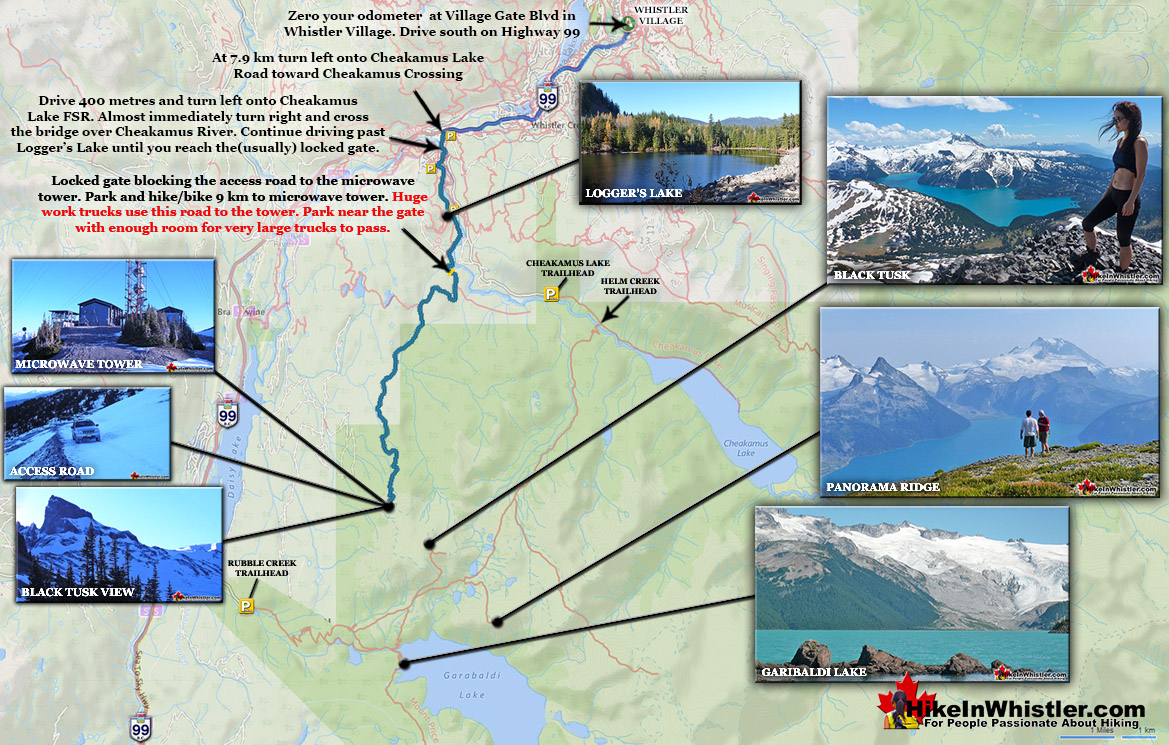
Camping Near Black Tusk
![]() From the Black Tusk(Garibaldi) Rubble Creek trailhead Garibaldi Lake is 9 kilometres along a well used and moderately challenging, continuously ascending trail that some find exhausting. Taylor Meadows branches off from this trail partway to Garibaldi Lake. From Rubble Creek to Taylor Meadows is 7.5 kilometres. Both Taylor Meadows and Garibaldi Lake are pay-to-use campgrounds with outhouses, tent pads, picnic tables, day-use food storage huts and a park ranger often in the area. There are no garbage facilities in any Garibaldi Provincial Park campgrounds, so you will always need to pack out what you pack in. Nearly everywhere you hike in Garibaldi Park you will have plenty of fresh water sources and though you see frequent warnings to treat or filter water must hikers usually don’t. With the exception of the water sources at the Garibaldi Lake campsite and the Elfin Lakes campsite, where treating and filtering water is highly recommended. Getting a water borne illness from water in the park is very rare because of the sources of water are glacier fed streams. Still, even an extremely remote chance of getting giardia(beaver fever) is reason enough to make a practice of treating or filtering water. With modern, extremely inexpensive water treatment tablets, treating water takes just seconds.
From the Black Tusk(Garibaldi) Rubble Creek trailhead Garibaldi Lake is 9 kilometres along a well used and moderately challenging, continuously ascending trail that some find exhausting. Taylor Meadows branches off from this trail partway to Garibaldi Lake. From Rubble Creek to Taylor Meadows is 7.5 kilometres. Both Taylor Meadows and Garibaldi Lake are pay-to-use campgrounds with outhouses, tent pads, picnic tables, day-use food storage huts and a park ranger often in the area. There are no garbage facilities in any Garibaldi Provincial Park campgrounds, so you will always need to pack out what you pack in. Nearly everywhere you hike in Garibaldi Park you will have plenty of fresh water sources and though you see frequent warnings to treat or filter water must hikers usually don’t. With the exception of the water sources at the Garibaldi Lake campsite and the Elfin Lakes campsite, where treating and filtering water is highly recommended. Getting a water borne illness from water in the park is very rare because of the sources of water are glacier fed streams. Still, even an extremely remote chance of getting giardia(beaver fever) is reason enough to make a practice of treating or filtering water. With modern, extremely inexpensive water treatment tablets, treating water takes just seconds.
From the trailhead at Rubble Creek the trail forks at 5.5 kilometres, left to Taylor Meadows and right to Garibaldi Lake. A continuing trail leads to Black Tusk and further along another trail extends to Panorama Ridge. These are two amazing and challenging destinations for this area of the park. Black Tusk is 13.5 kilometres from the Rubble Creek trailhead and Panorama Ridge is 15 kilometres. So tackling both in a day hike is not realistic for most hikers. Even hiking to one of these in a day hike is too much for most hikers. Therefore an overnight base camp at Taylor Meadows or Garibaldi Lake are the usual alternative. Though a day hike is a good endurance test, taking your time allows you to appreciate the view from the summit of Black Tusk, or the stunning panorama from Panorama Ridge, or the flower filled valleys along the way. This Black Tusk area of Garibaldi Park is marvelous for a lot of geological features besides Black Tusk, but Black Tusk is quite a marvel that outshines all the rest in the park.
Garibaldi Lake Campground in Garibaldi Park
![]()
Day hiking in Garibaldi Provincial Park is free, but parking at trailheads requires a free day-use pass, reservable online at https://camping.bcparks.ca/. Overnight camping requires a campsite reservation, also made online. There are ten official BC Parks campgrounds with well-designed tent pads, all reservable year-round except Red Heather (winter-only). Wilderness camping is permitted in designated areas for $10 per person per night, with restrictions to manage park impact. Fees are $12 per adult (16+) and $6 per child (6-15) per night in 2025, with children under 6 free. Reservations are site-specific but not for individual tent pads (first-come, first-served upon arrival). The campground at Garibaldi Lake is the largest and most popular in Garibaldi Park with 50 tent pads. It is open year-round, although it is only busy in the summer months. Though you get some skier and snowboarder activity in the winter, the snow and cold weather keeps people away. Along with the 50 tent pads, you have plenty of outhouses, picnic tables and a bear-proof hut for preparing and storing food. No sleeping is allowed in the hut. At the end of the campsites you will find a BC Parks ranger cabin which is often manned in the summer and sporadically the rest of the year. The campsites at Garibaldi Lake and Taylor Meadows are popular bases for hiking to Black Tusk and/or Panorama Ridge. The Helm Creek campground on the other side of Black Tusk and Panorama Ridge is another good base for these amazing sights. Generally Helm Creek is hiked from the Cheakamus Lake trailhead instead of the Rubble Creek trailhead. Fees: $12 Adult, $6 Kids (6-15)
There are no well defined hiking trails around the lake. The Panorama Ridge side of the lake is far to steep and wild to make a trail feasible. On the other side of the lake, hiking is possible to Mount Price, although the faint trail disappears into the alpine and route-finding can get very difficult. There are some trail markings that denote the trail past the BC Parks ranger cabin a the far end of the Garibaldi Lake campsite. Plenty of hikers have hiked around Garibaldi Lake in the past, but you have to know what you are doing and be well equipped, tough and determined to do it.
Taylor Meadows Campground in Garibaldi Park
![]() Near Garibaldi Lake is another popular and beautiful campground at Taylor Meadows. Taylor Meadows lacks the beautiful lake and distant glacier views you get from the campsite at Garibaldi Lake. You do get a much prettier forest and meadow setting at Taylor Meadows as well as stunning views of the always impressive Black Tusk. Fresh water is plentiful here as well as there is a pristine, glacier fed creek that runs through the campsites. As with Garibaldi Lake you have a food storage and preparation hut to use and there is a frequently manned ranger cabin nearby as well. Taylor Meadows has 40 well-spaced and organized tent pads sprinkled throughout the beautiful forest here. Though Garibaldi Lake is often considered the better campsite because you can swim in the stunningly beautiful, though frigidly cold lake, Taylor Meadows is beautiful with its lush green and flower filled meadows surrounding the campsite. Taylor Meadows tends to feel less hectic as Garibaldi Lake tends to draw the majority of visitors to the park. Both Taylor Meadows and Garibaldi Lake campsites are good if you are hiking to Black Tusk or Panorama Ridge as both connect to the Black Tusk trail and or the Panorama Ridge trail.
Near Garibaldi Lake is another popular and beautiful campground at Taylor Meadows. Taylor Meadows lacks the beautiful lake and distant glacier views you get from the campsite at Garibaldi Lake. You do get a much prettier forest and meadow setting at Taylor Meadows as well as stunning views of the always impressive Black Tusk. Fresh water is plentiful here as well as there is a pristine, glacier fed creek that runs through the campsites. As with Garibaldi Lake you have a food storage and preparation hut to use and there is a frequently manned ranger cabin nearby as well. Taylor Meadows has 40 well-spaced and organized tent pads sprinkled throughout the beautiful forest here. Though Garibaldi Lake is often considered the better campsite because you can swim in the stunningly beautiful, though frigidly cold lake, Taylor Meadows is beautiful with its lush green and flower filled meadows surrounding the campsite. Taylor Meadows tends to feel less hectic as Garibaldi Lake tends to draw the majority of visitors to the park. Both Taylor Meadows and Garibaldi Lake campsites are good if you are hiking to Black Tusk or Panorama Ridge as both connect to the Black Tusk trail and or the Panorama Ridge trail.
If you are hiking Black Tusk or Panorama Ridge in a day from Rubble Creek you can hike one route up and the other down. So you can hike through Taylor Meadows, up to Black Tusk or Panorama Ridge, then return via Garibaldi Lake for a swim. It is always nice to avoid retracing your steps in a hike and this way you only duplicate part of the trail in the first or last 5.5 kilometres where the trail forks left to Taylor Meadows or right to Garibaldi Lake. Fees: $12 Adult, $6 Kids (6-15).
Helm Creek Campground in Garibaldi Park
![]() Helm Creek is the other BC Parks campground in this part of Garibaldi Provincial Park. Taylor Meadows and Garibaldi Lake campgrounds are on one side of Black Tusk and Panorama Ridge and the Helm Creek campground is on the other side. Part way to Cheakamus Lake, Helm Creek is much less busy, though you still find it full on many summer weekends. Helm Creek has 30 well spaced tent pads in a large meadow with Helm Creek surrounding it in one large arc. Helm Creek has bear proof cables on pulleys to lift your food out of reach of hungry bears. There are outhouses at Helm Creek, but the campground is wonderfully free of human constructions. If you are lucky enough to find yourself to be the only campers there you have the wonderful feeling that you have the whole of Garibaldi Park to yourself. Surrounding your tent you see only meadow, and idyllic creek and wilderness forest and mountains all around. One of those mountains is the wonderfully surreal and close Black Tusk.
Helm Creek is the other BC Parks campground in this part of Garibaldi Provincial Park. Taylor Meadows and Garibaldi Lake campgrounds are on one side of Black Tusk and Panorama Ridge and the Helm Creek campground is on the other side. Part way to Cheakamus Lake, Helm Creek is much less busy, though you still find it full on many summer weekends. Helm Creek has 30 well spaced tent pads in a large meadow with Helm Creek surrounding it in one large arc. Helm Creek has bear proof cables on pulleys to lift your food out of reach of hungry bears. There are outhouses at Helm Creek, but the campground is wonderfully free of human constructions. If you are lucky enough to find yourself to be the only campers there you have the wonderful feeling that you have the whole of Garibaldi Park to yourself. Surrounding your tent you see only meadow, and idyllic creek and wilderness forest and mountains all around. One of those mountains is the wonderfully surreal and close Black Tusk.
Helm Creek is a cute, meandering creek that winds its way from beyond Black Tusk, down the valley to the wonderful campground that takes its name. From the Helm Creek campground, Helm Creek descends further along the Helm Creek trail, until it joins Cheakamus River, not far from where it leaves Cheakamus Lake. The location of Helm Creek campground is pretty amazing for a variety of reasons. First it is just a great location. About halfway between Cheakamus Lake and Black Tusk it lays in some amazingly scenic areas. Beautiful, climbable mountains all around. Pristine fields of snow that run all the way to the base of Black Tusk well into July. Rivers, creeks and waterfalls everywhere you look from the idyllic campground. A large, grassy field ringed by trees and Helm Creek. What you always want from a campground is a convenient and clean water source and of course Helm Creek is both. Another aspect of a great campground is a variety of beautiful views and a serene setting and again Helm Creek has both of these. The campground is so widespread that even if the area becomes busy, you can still manage to not hear your neighbours. The area really has no defined trails except the Helm Creek trail that runs past the campsite, but there are infinitely numerous directions you can wander. Exploring in any direction takes you to more and more pristine, green fields, streams, pocket lakes and mountain views. Though most just use it as a base to extend onto Black Tusk, it is a great base for so much more. Helm Peak, Corrie Peak, Cinder Cone, Empetrum Peak as well as the more frequented Panorama Ridge, Black Tusk and Garibaldi Lake.
The Helm Creek Approach to Black Tusk
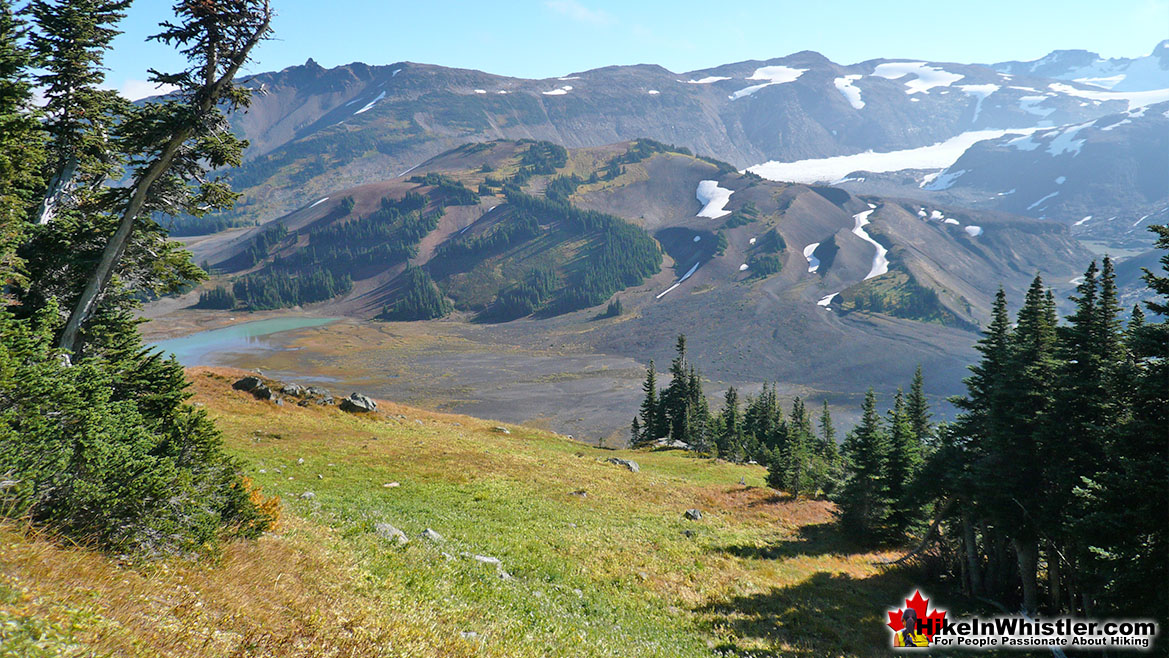
Possibly the nicest aspect of Helm Creek as a campground is that it is quiet and serene when compared with the other two area campgrounds. Garibaldi Lake and Taylor Meadows are very busy all summer long. In fact there is a posting part way up the trail to Garibaldi Lake indicating how crowded it is and if it is full. At Helm Creek you find yourself in a remote and quiet valley in the midst of paradise. From the trail junction in the campground you see the enticing sign indicating what is around you. The nice, well marked trail continues to Panorama Ridge in 7 kilometres. Black Tusk in 9.5 kilometres or Garibaldi Lake in 9 kilometres. All of these destinations branch off the main trail that ascends away from Helm Creek. Fees: $12 Adult, $6 Kids (6-15).
Hiking Season in Garibaldi Provincial Park
Garibaldi Provincial Park is located in the high alpine of the Coast Mountains that stretches from Alaska, down the coast of British Columbia. Snow accumulation over the winter months is measured in metres and varies tremendously year to year. This makes gauging when the snow will recede from the Garibaldi Park trails difficult to know until just weeks before. In just the last 10 years you could have hiked to Garibaldi Lake in late May while encountering little snow on the trail. In other years deep snow on the trail persists well into June and even early July! I once spent a couple nights at Helm Creek over the Canada Day long weekend on July 1st and my tent was on a metre of snow! The following year the same spot was in a snow free, green meadow in mid June. There are a couple good ways to find out, or guess how much snow is on the trails. BC Parks releases trip reports every couple weeks over the spring and summer months and included details of the snow depths along the various trails. If the trip report is a couple weeks old, you can pretty accurately estimate the current snowpack.
Another good way is to take a look at the many Whistler Mountain and Blackcomb Mountain web cams. The Roundhouse Lodge has a great camera on it every day of the year and it will show the snow levels that you can then compare to comparable elevations in Garibaldi Park. For the most part, even in very snowy winters, the determined can hike to places like Garibaldi Lake, Taylor Meadows, Black Tusk and Elfin Lakes in late June. Though you will encounter snow along the trail in the alpine that will make you wish you brought snowshoes and gaiters. The trail to Wedgemount Lake is much steeper and snow impedes your way a lot more than on other trails. Prepare to fight the snowy trail into early July! Another measure of the snowpack is the opening dates from hiking trails on Whistler Mountain and Blackcomb Mountain. The higher elevation trails don’t usually open until early July, though the hiking season officially starts in late May for hiking trails from the Roundhouse on Whistler Mountain.
You need to be well prepared whenever you are hiking in Garibaldi Park, but more so in the early summer weeks. The alpine weather can change quickly and you should always have warm clothes with you well beyond the temperatures you are anticipating. It takes little room in your backpack to bring along a toque, gloves and warm pants. Whistler and Vancouver locals always tend to throw their snowboard/ski pants in their pack even on a sunny August overnight hike. For many hikers to Garibaldi Provincial Park, the extraordinary flower meadows are a highlight. Similar to gauging the winter snow lingering on the trails in the spring months, estimating when the flowers bloom is tricky as well. Most years you will encounter extraordinary meadows of red, yellow and white flowers. Laying in enormous meadows of bright green, the flowers are amazing to see. Along the trail to Panorama Ridge via Taylor Meadows you will pass by a continuously varying array of flower fields that seem impossibly beautiful. Seas of red, yellow and white fill the valleys, giving way to snowy mountains and grey and black mountain peaks.
Facilities in Garibaldi Park Near Black Tusk
![]() There are outhouses(toilets) at various places in Garibaldi Park along the trail to Black Tusk. The parking lot/trailheads at Rubble Creek and Cheakamus Lake have outhouses. The campsites at Taylor Meadows and at Garibaldi Lake have outhouses. There is also an outhouse at the trail junction where the Black Tusk trail ascends from the main trail, 3.5k from Black Tusk. These are basic, pit toilets, usually equipped with toilet paper. At the campsites at Taylor Meadows and Garibaldi Lake you will find nice, one room buildings for food preparation and to keep them away from bears. Beware of mice in these places. If you leave anything on the floor with food in it, such as a backpack with a chocolate bar in a pocket. You will find little holes chewed through and your candy bar gone! There are plenty hooks on the wall to hang things from, out of reach of the attacking mice.
There are outhouses(toilets) at various places in Garibaldi Park along the trail to Black Tusk. The parking lot/trailheads at Rubble Creek and Cheakamus Lake have outhouses. The campsites at Taylor Meadows and at Garibaldi Lake have outhouses. There is also an outhouse at the trail junction where the Black Tusk trail ascends from the main trail, 3.5k from Black Tusk. These are basic, pit toilets, usually equipped with toilet paper. At the campsites at Taylor Meadows and Garibaldi Lake you will find nice, one room buildings for food preparation and to keep them away from bears. Beware of mice in these places. If you leave anything on the floor with food in it, such as a backpack with a chocolate bar in a pocket. You will find little holes chewed through and your candy bar gone! There are plenty hooks on the wall to hang things from, out of reach of the attacking mice.
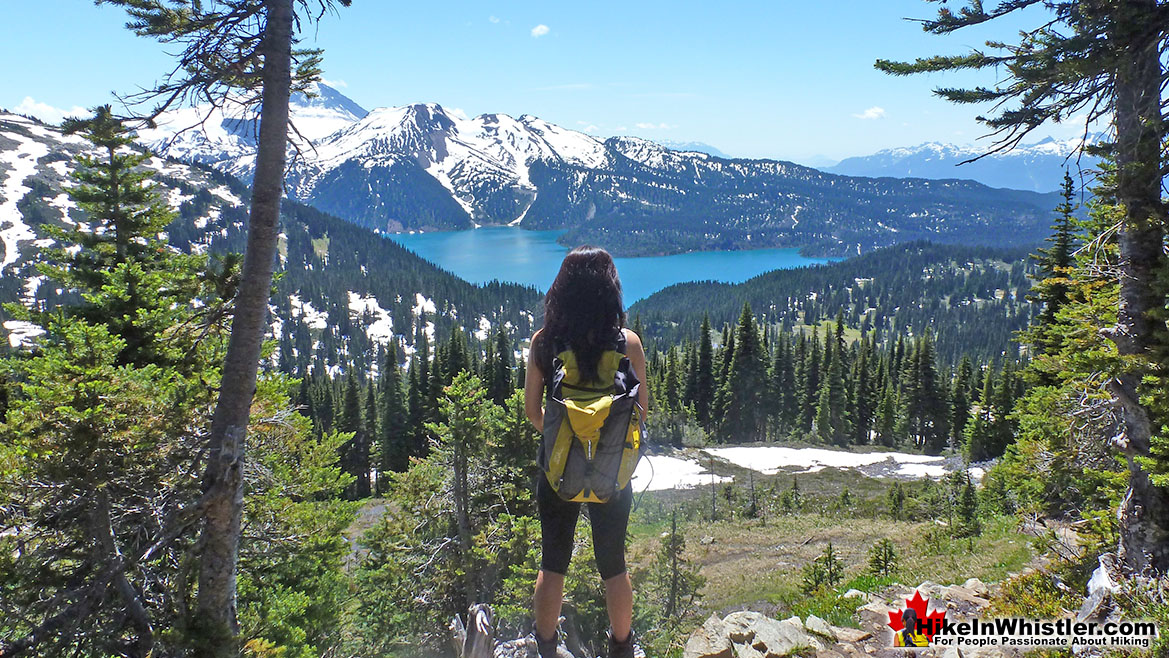
Restrictions in Garibaldi Park - Black Tusk
![]()
![]()
![]()
![]() Bikes are not allowed in much of Garibaldi Park, including the routes to Black Tusk. You can bike to Cheakamus Lake, but not up to Helm Creek toward Black Tusk. Use of motorized vehicles of any kind are restricted to park roads and parking areas. Fires are prohibited in the park due to the potential forest fire hazard. Arriving or departing the park by aircraft is not allowed, as well as harvesting natural resources such as mushrooms. Dogs are not permitted on the trail to Black Tusk or any other Garibaldi Provincial Park trails out of courtesy to the resident animals. There are a large number of black bears in the park and encounters with dogs result in unpredictable and potentially dangerous conflicts. There are quite a few excellent hiking trails in Whistler that are dog friendly. Whistler's Valley Trail and Lost Lake trails are dog friendly and run throughout Whistler. The Sea to Sky Trail, which runs over 30 kilometres through Whistler is a paradise trail for dogs as it runs through numerous parks, beaches and forests. Ancient Cedars is a nice, dog friendly hike that is 5k roundtrip and takes you into a thousand year old forest. Train Wreck is also dog friendly as well as the Rainbow-Sproatt Flank Trail that cuts along both Rainbow Mountain and Mount Sproatt. South of Whistler you will come to Brandywine Falls, which is a short, 2k (roundtrip) dog friendly hike to the amazing falls. About 25 minutes north of Whistler, Nairn Falls is another beautiful and dog friendly hiking trail.
Bikes are not allowed in much of Garibaldi Park, including the routes to Black Tusk. You can bike to Cheakamus Lake, but not up to Helm Creek toward Black Tusk. Use of motorized vehicles of any kind are restricted to park roads and parking areas. Fires are prohibited in the park due to the potential forest fire hazard. Arriving or departing the park by aircraft is not allowed, as well as harvesting natural resources such as mushrooms. Dogs are not permitted on the trail to Black Tusk or any other Garibaldi Provincial Park trails out of courtesy to the resident animals. There are a large number of black bears in the park and encounters with dogs result in unpredictable and potentially dangerous conflicts. There are quite a few excellent hiking trails in Whistler that are dog friendly. Whistler's Valley Trail and Lost Lake trails are dog friendly and run throughout Whistler. The Sea to Sky Trail, which runs over 30 kilometres through Whistler is a paradise trail for dogs as it runs through numerous parks, beaches and forests. Ancient Cedars is a nice, dog friendly hike that is 5k roundtrip and takes you into a thousand year old forest. Train Wreck is also dog friendly as well as the Rainbow-Sproatt Flank Trail that cuts along both Rainbow Mountain and Mount Sproatt. South of Whistler you will come to Brandywine Falls, which is a short, 2k (roundtrip) dog friendly hike to the amazing falls. About 25 minutes north of Whistler, Nairn Falls is another beautiful and dog friendly hiking trail.
Helm Creek Route to Black Tusk
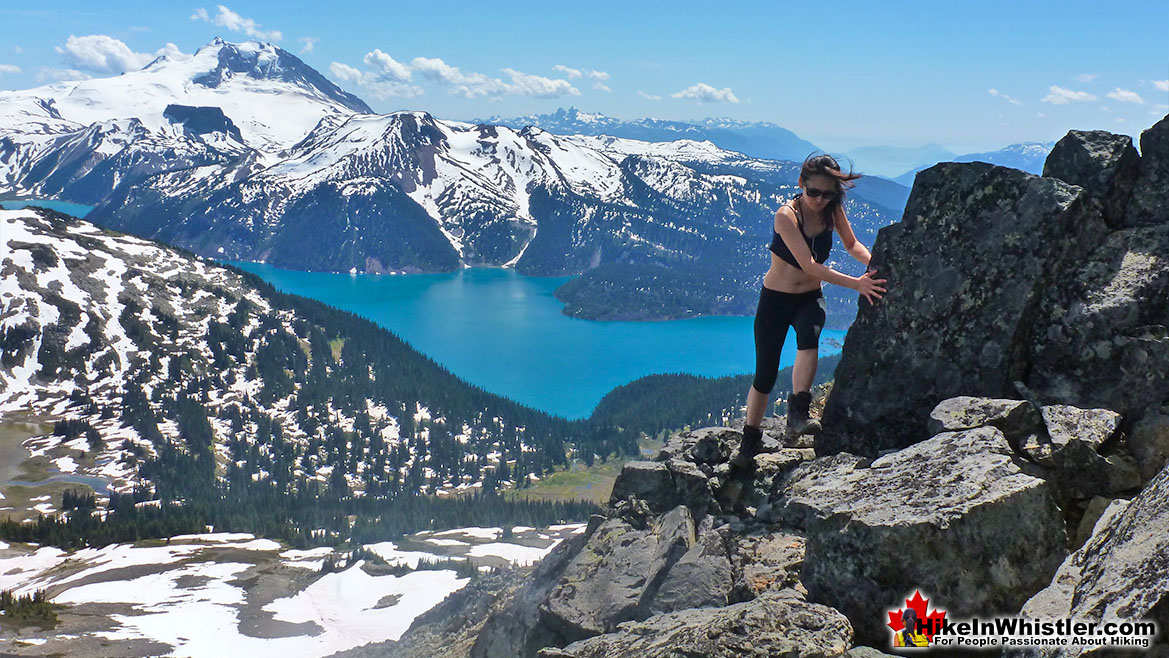
Wildlife in Garibaldi Provincial Park - Black Tusk
![]() Black Tusk sits in the midst of an almost untouched and pristine wilderness of Garibaldi Park with a lot of wildlife to see. Black bears and hoary marmots can be occasionally spotted. Black bears in the park are reclusive and not easily spotted. Hoary marmots, however, will emerge from nowhere and whistle to each other to help monitor any threats. Hoary marmots are cute, invariably pudgy, twenty plus pound ground squirrels that have evolved to live quite happily in the hostile alpine areas of much of the world. In the northwest of North America, marmots have a distinct grey in their hair, a hoary colour, so have been named hoary marmots. They manage to survive quite happily in the alpine, largely by hibernating for 8 months of the year and largely for having a surprisingly varied array of food in such an inhospitable environment. They live off of grasses, berries, lichens, mosses, and roots and flowers. And live quite well it seems, as they always look chubby, which has one great drawback. They are sought after by bears and wolves. They have a wonderful defence system though. They are constantly on watch and whistle loudly at the first sign of danger, alerting the colony. The prevalence of these "whistlers" as they came to be locally called, in the early days of London Mountain resulted in it's name being changed to Whistler Mountain in the 60's. Hiking on Whistler Mountain, Blackcomb Mountain or to Wedgemount Lake in the summer will almost guarantee an encounter with a chubby, jolly little Whistler hoary marmot.
Black Tusk sits in the midst of an almost untouched and pristine wilderness of Garibaldi Park with a lot of wildlife to see. Black bears and hoary marmots can be occasionally spotted. Black bears in the park are reclusive and not easily spotted. Hoary marmots, however, will emerge from nowhere and whistle to each other to help monitor any threats. Hoary marmots are cute, invariably pudgy, twenty plus pound ground squirrels that have evolved to live quite happily in the hostile alpine areas of much of the world. In the northwest of North America, marmots have a distinct grey in their hair, a hoary colour, so have been named hoary marmots. They manage to survive quite happily in the alpine, largely by hibernating for 8 months of the year and largely for having a surprisingly varied array of food in such an inhospitable environment. They live off of grasses, berries, lichens, mosses, and roots and flowers. And live quite well it seems, as they always look chubby, which has one great drawback. They are sought after by bears and wolves. They have a wonderful defence system though. They are constantly on watch and whistle loudly at the first sign of danger, alerting the colony. The prevalence of these "whistlers" as they came to be locally called, in the early days of London Mountain resulted in it's name being changed to Whistler Mountain in the 60's. Hiking on Whistler Mountain, Blackcomb Mountain or to Wedgemount Lake in the summer will almost guarantee an encounter with a chubby, jolly little Whistler hoary marmot.
Biking or Walking Directions to Black Tusk
![]() Biking to one of the Garibaldi Park trailheads for Black Tusk is unexpectedly easy. The Cheakamus Lake trailhead is just 15.1 kilometres(9.4 miles) from Whistler Village. The last 8 kilometres is a bit of a grind though as you ascend quite a bit to the Cheakamus Lake parking lot. Bikes are allowed on the Cheakamus Lake Lake trail, so you can ride the nice and easy trail for 1.5 kilometres, park your bike, then start your hike(bikes are prohibited on the connecting trail to Black Tusk. The route to Black Tusk via the microwave tower is an excellent way to bike, then hike. In fact, biking to the microwave tower is the preferred way to get there by most. It's a bit of a long, boring hike along a gravel, deep forest road. On a bike, however, it is much quicker and riding out at the end of your trip is all down hill. The Rubble Creek trailhead is probably the least bike friendly trailhead owing to its distance from Whistler Village. 27.2 kilometres(16.9 miles) is too far for most to bike to a trailhead and begin an arduous hike!
Biking to one of the Garibaldi Park trailheads for Black Tusk is unexpectedly easy. The Cheakamus Lake trailhead is just 15.1 kilometres(9.4 miles) from Whistler Village. The last 8 kilometres is a bit of a grind though as you ascend quite a bit to the Cheakamus Lake parking lot. Bikes are allowed on the Cheakamus Lake Lake trail, so you can ride the nice and easy trail for 1.5 kilometres, park your bike, then start your hike(bikes are prohibited on the connecting trail to Black Tusk. The route to Black Tusk via the microwave tower is an excellent way to bike, then hike. In fact, biking to the microwave tower is the preferred way to get there by most. It's a bit of a long, boring hike along a gravel, deep forest road. On a bike, however, it is much quicker and riding out at the end of your trip is all down hill. The Rubble Creek trailhead is probably the least bike friendly trailhead owing to its distance from Whistler Village. 27.2 kilometres(16.9 miles) is too far for most to bike to a trailhead and begin an arduous hike!
Public Transit Directions to Black Tusk
![]() Can you get to a Garibaldi Park trailhead to hike to Black Tusk by public transit from Whistler? Not even close. No bus service will stop at the highway turnoff to Rubble Creek. The Cheakamus Lake trailhead is a possible option. The Whistler Public Transit goes between the Village and Cheakamus Crossing almost constantly. The problem of course, is you then have to hike 8 kilometres to the Cheakamus Lake trailhead. A taxi to the trailhead may be an option, however you will have to let the taxi company know where you are going as, depending on the driver, some won't drive any logging roads. Taking a taxi to the Rubble Creek trailhead is a decent option, depending on your budget. The ride will cost you about $45, each way. It does, however give you the amazing option to exit at Cheakamus Lake so you don't cover the same ground twice. If you are coming from Vancouver you do have a public transit option that is very good. ParkBus.ca will bring you from downtown Vancouver to the Rubble Creek trailhead for just $49(each way).
Can you get to a Garibaldi Park trailhead to hike to Black Tusk by public transit from Whistler? Not even close. No bus service will stop at the highway turnoff to Rubble Creek. The Cheakamus Lake trailhead is a possible option. The Whistler Public Transit goes between the Village and Cheakamus Crossing almost constantly. The problem of course, is you then have to hike 8 kilometres to the Cheakamus Lake trailhead. A taxi to the trailhead may be an option, however you will have to let the taxi company know where you are going as, depending on the driver, some won't drive any logging roads. Taking a taxi to the Rubble Creek trailhead is a decent option, depending on your budget. The ride will cost you about $45, each way. It does, however give you the amazing option to exit at Cheakamus Lake so you don't cover the same ground twice. If you are coming from Vancouver you do have a public transit option that is very good. ParkBus.ca will bring you from downtown Vancouver to the Rubble Creek trailhead for just $49(each way).
More Great Hiking Around Black Tusk
![]() The hiking options around and beyond Black Tusk in Garibaldi Park are quite good. Most hike to Garibaldi Lake to camp on the way to Black Tusk. Taylor Meadows is another route to Black Tusk and another campground. If you are hiking in a day, you can hike Rubble Creek to Taylor Meadows, then Black Tusk, returning via Garibaldi Lake. Garibaldi Lake barely adds any hiking distance to the overall journey with just a couple extra kilometres. Panorama Ridge, Helm Creek and Cheakamus Lake are found beyond Black Tusk if hiking from the Rubble Creek side. Added to this you will find a wealth of alpine terrain leading to various mountain peaks and even the wonderful Helm Glacier. Garibaldi Provincial Park is an enormous park, but the huge outdoor playground around Black Tusk is absolutely phenomenal!
The hiking options around and beyond Black Tusk in Garibaldi Park are quite good. Most hike to Garibaldi Lake to camp on the way to Black Tusk. Taylor Meadows is another route to Black Tusk and another campground. If you are hiking in a day, you can hike Rubble Creek to Taylor Meadows, then Black Tusk, returning via Garibaldi Lake. Garibaldi Lake barely adds any hiking distance to the overall journey with just a couple extra kilometres. Panorama Ridge, Helm Creek and Cheakamus Lake are found beyond Black Tusk if hiking from the Rubble Creek side. Added to this you will find a wealth of alpine terrain leading to various mountain peaks and even the wonderful Helm Glacier. Garibaldi Provincial Park is an enormous park, but the huge outdoor playground around Black Tusk is absolutely phenomenal!
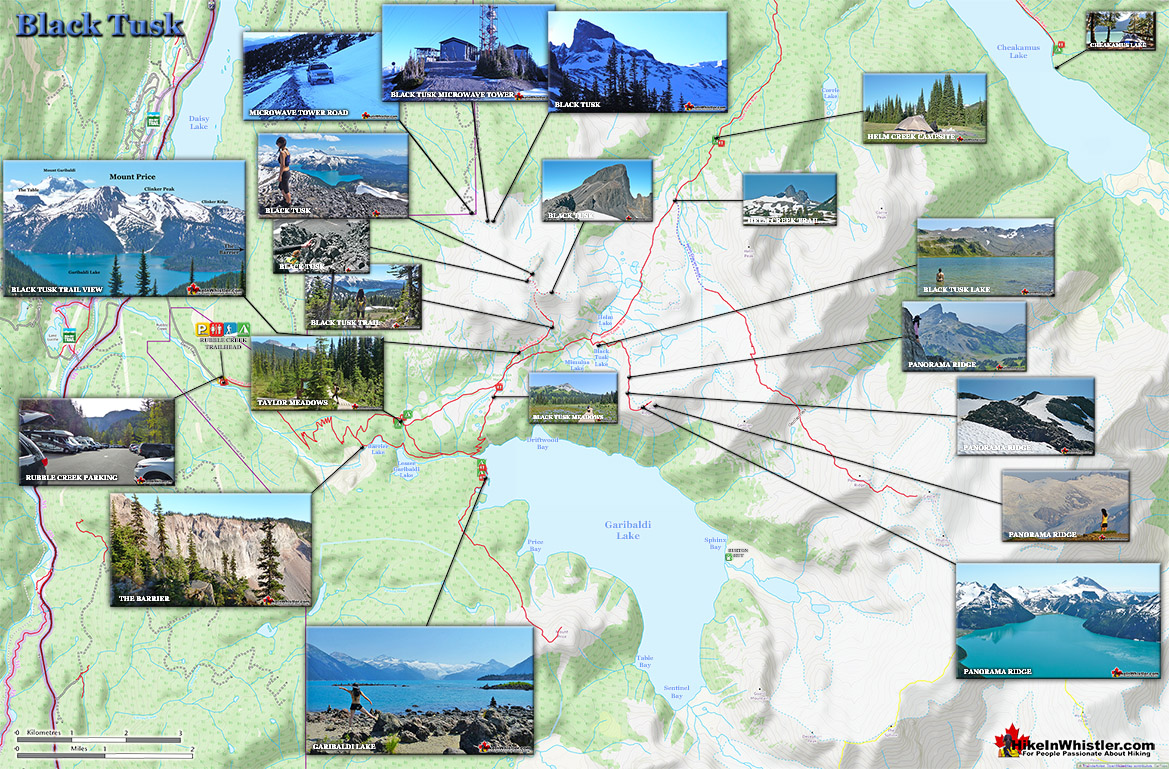
Guides to the Best of Whistler
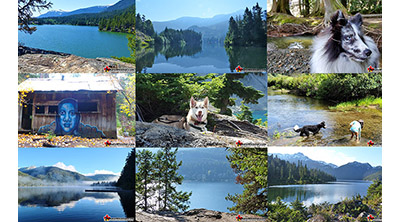 Best Dog Friendly Hiking Trails
Best Dog Friendly Hiking Trails
Whistler is very dog friendly and the number of wonderful hiking trails that your dog will love is huge. The massively varied hiking trails range from easy, short, close to Whistler Village to challenging, long and deep in the endless wilderness around Whistler. You can find dog friendly trails in and around Whistler Village that take you through deep, dark and magical forests. Or you can drive beyond Whistler Village and take your dog to spectacular alpine lakes. Some requiring little or no hiking, while others are found after hiking challenging and long trails. Many of these places are comparatively quiet and often you and your dog will have the the wilderness to yourselves. In and around Whistler Village you have Lost Lake with its spider web of trails... Continued here.
 Best Free Whistler Camping
Best Free Whistler Camping
Whistler is surrounded by an immense wilderness dotted with spectacular, hidden lakes and amazing places to set up a tent. Decades of logging activity has left a network of forest service roads that has opened easy access to these places. Some of these you can drive to and some you may need a 4x4 to comfortably get to. Some places to camp for free you can drive to, some require a short hike and others are fairly long hikes to reach. Beautiful Callaghan Valley is home to several incredible and free places to camp. Callaghan Lake has a great free drive-to campsite just steps from this spectacular alpine lake. If you have a canoe, you can paddle to the end of Callaghan Lake and hike the short, but steep trail up to Cirque Lake. This gorgeous lake is deep in the alpine wilderness... Continued here.
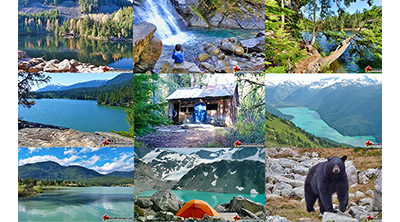 No Car? No Problem! Whistler Trails
No Car? No Problem! Whistler Trails
Whistler as a resort has a wonderful car-free core. The Village Stroll runs through the heart of Whistler Village and is entirely car free. If you are visiting Whistler or living here and you don't have a car, it's no problem. On foot or on a bike you can travel the extensive network of non-motorized trails. The Valley Trail snakes through Whistler Village and extends in several directions, all of which lead to beautiful parts of Whistler. The Sea to Sky Trail and the Lost Lake trails continue this massive, car-free network of trails running almost everywhere in Whistler. When it comes to many of the best hiking trails, getting to the trailheads on foot, by bike or public transit can be tricky at best or complicated and impractical at worst. Many trailheads are far from Whistler Village and... Continued here.
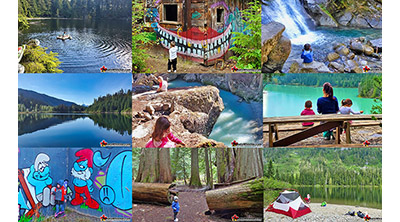 Kid Friendly Whistler Hiking Trails
Kid Friendly Whistler Hiking Trails
There are plenty of excellent, kid and family friendly hiking trails and destinations in and around Whistler. Kid and family friendly generally means an easy and somewhat short trail that a toddler can happily manage. Some of these trails are flat enough to be stroller friendly, such as Brandywine Falls, Whistler Mountain and Blackcomb Mountain. Others such as Logger’s Lake, Cheakamus River and Madeley Lake have short enough trails to reach them that you can manage with little kids that don't want to hike too far. Some of these hikes and walks are popular and close to Whistler Village, like Whistler Mountain, Blackcomb Mountain, Lost Lake Park, Rainbow Park and Meadow Park. Others are a beautiful, but far drive into the mountains and tricky to find... Continued here.
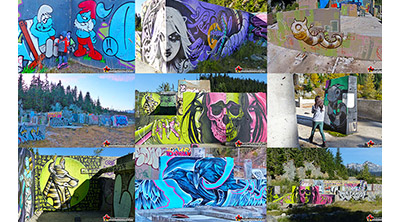 Northair Mine Murals
Northair Mine Murals
Way up in the Callaghan Valley on the back side of Mount Sproatt is an abandoned gold mine. Old cement foundations and two unexpectedly beautiful lakes mark the location of Northair Mine, abandoned in 1982. It was a fairly productive gold mine that extracted five tons of gold. Largely forgotten for years, in the last decade it has come to life in stunning colour by graffiti artists and professional muralists. In the summer of 2013, the first mural appeared on the blank foundation walls of Northair Mine. A creation of a professional Whistler artist PETKO. Painted on one of the inside, pillar walls, the mural is about 8 feet tall and five feet wide of what looks like a robot snake in front of a cube background. It stood out in striking contrast to the grey walls in the background... Continued here.
 Neal Carter Mountaineer
Neal Carter Mountaineer
Neal Carter (14 Dec 1902 – 15 Mar 1978) was a mountaineer and early explorer of the Coast Mountains primarily in the 1920’s and 1930’s. Highly skilled as a mountaineer and climber, Carter also excelled at cartography and surveying which he used to map the vast unnamed and unexplored mountains of BC. He named a staggering number of mountains and alpine features, as well as making at least 25 first ascents, many around what we now call the Whistler Valley. Carter began climbing the mountains around Vancouver as a teenager and at the age of seventeen he met someone who would change his life forever. In 1920, while hiking with high school friends Carter had a chance encounter with Tom Fyles, arguably the greatest mountaineer of the era. Continued here.
 Tom Fyles Mountaineer
Tom Fyles Mountaineer
Tom Fyles (27 June 1887 - 27 March 1979) was an astoundingly skilled climber that figured prominently in the mountaineering community in Vancouver for more than two decades. From his introduction to mountaineering in 1912, to his prolific array of elite level climbing ascents that began in earnest just four years later. In 1916 he solo climbed The Table in Garibaldi Park, a mountain widely considered to be too difficult and dangerous to even attempt. Those that knew him well admired his friendliness, enthusiasm, boundless endurance and incredible ability to read a mountain and navigate the best route to the summit. He made many first ascents and inspired countless new climbers, some becoming giants of the era. Continued here.
Whistler's Best Hiking Trails!
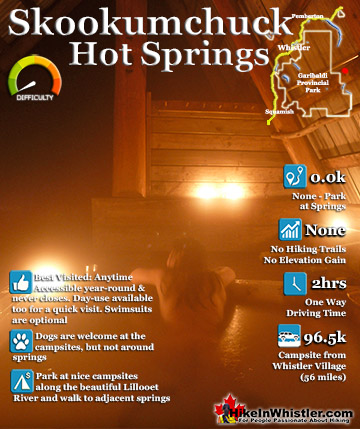
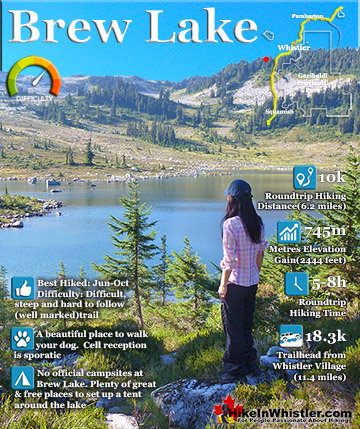
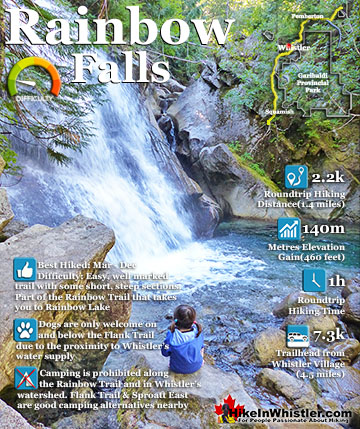
Whistler & Garibaldi Park Best Hiking by Month!


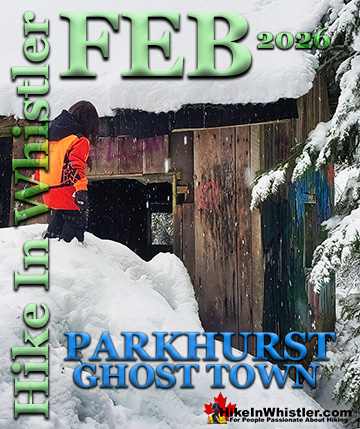
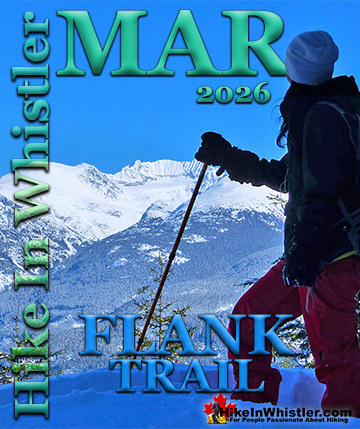
Explore BC Hiking Destinations!
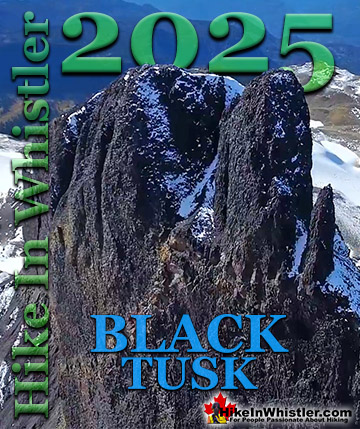
Whistler Hiking Trails
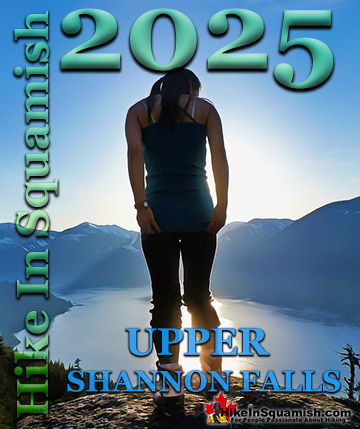
Squamish Hiking Trails
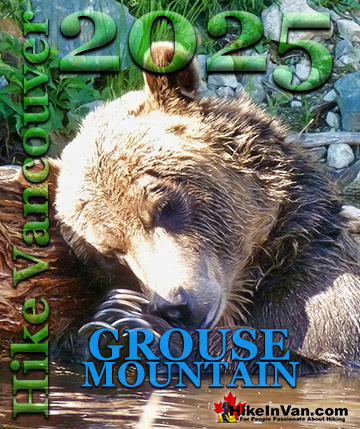
Vancouver Hiking Trails

Clayoquot Hiking Trails

Victoria Hiking Trails
